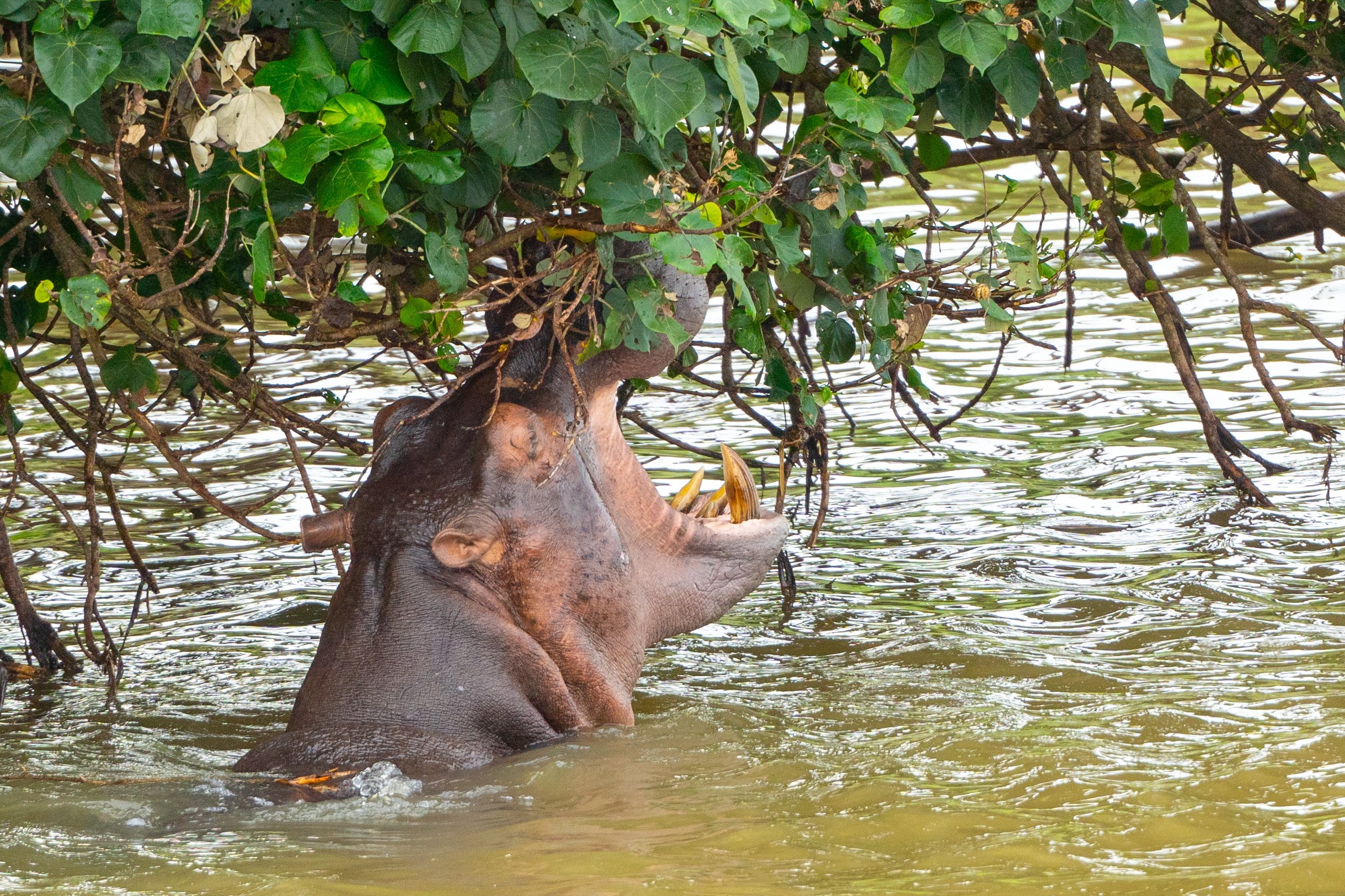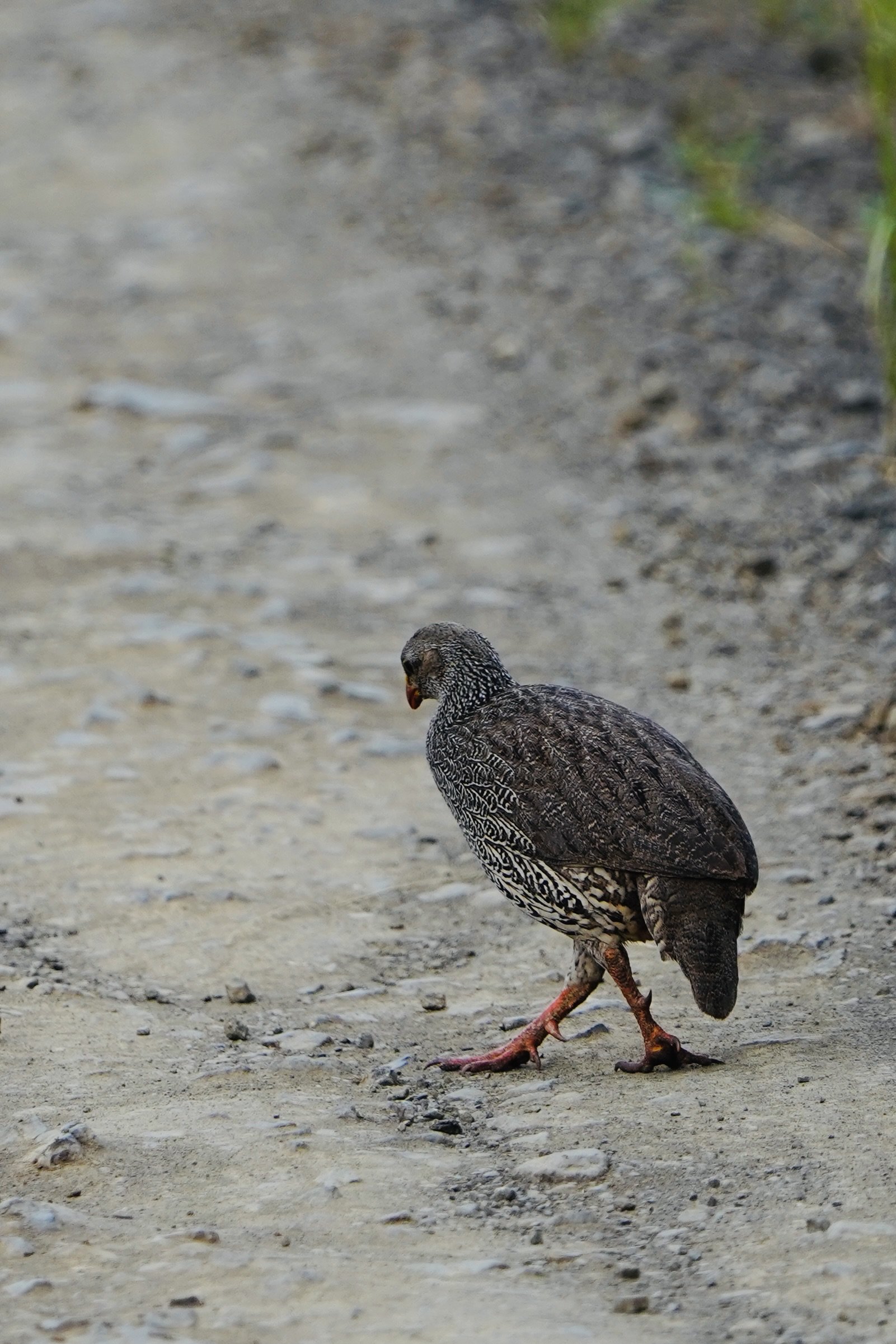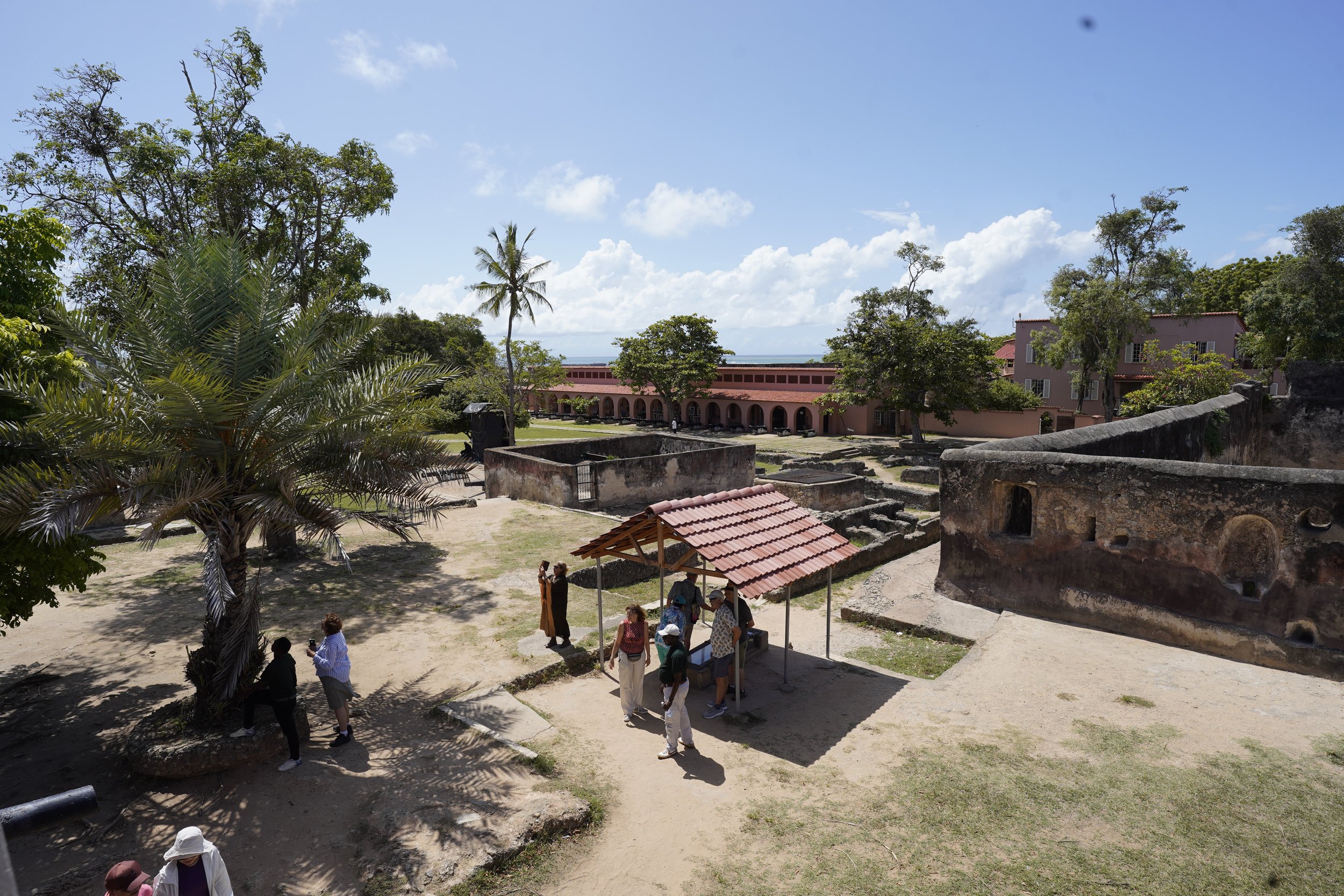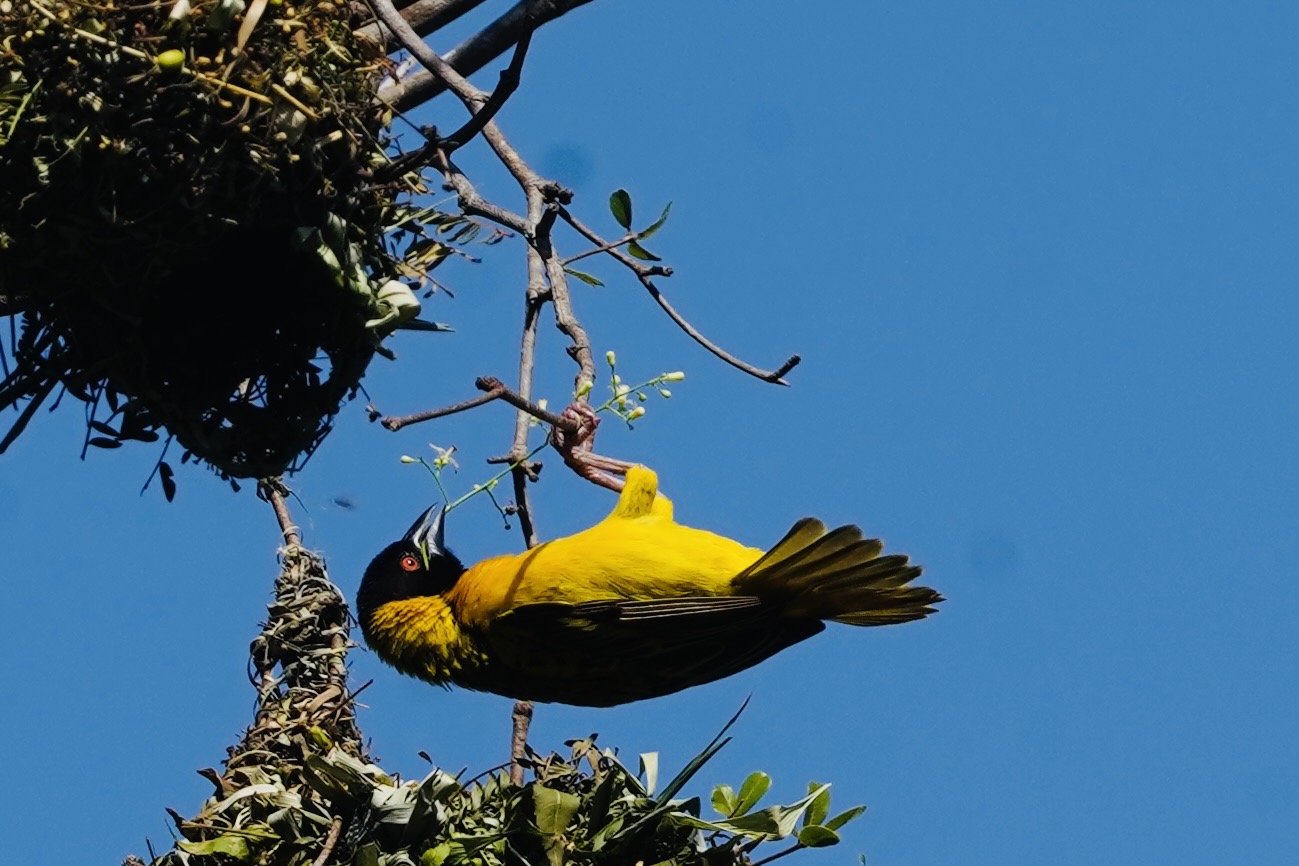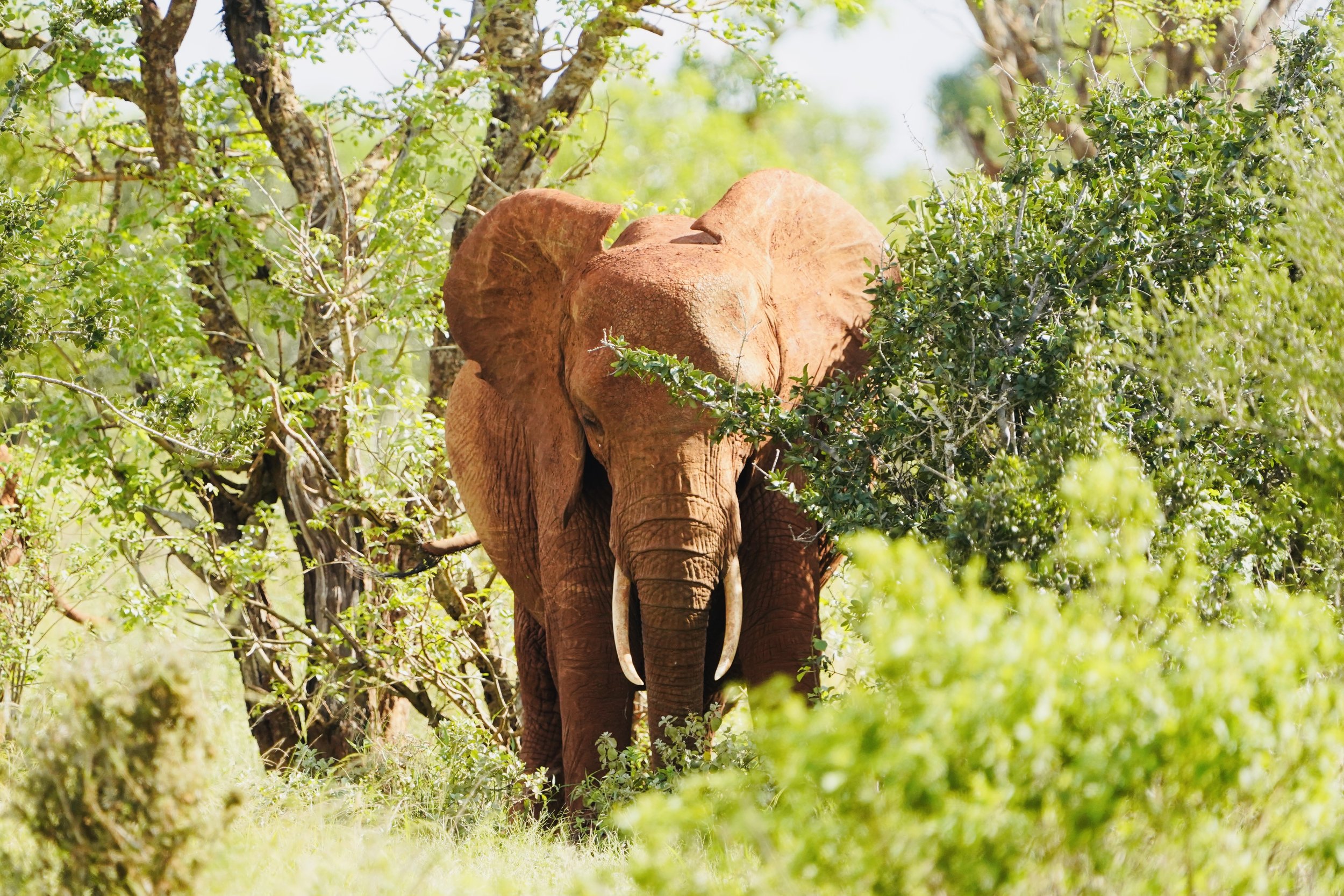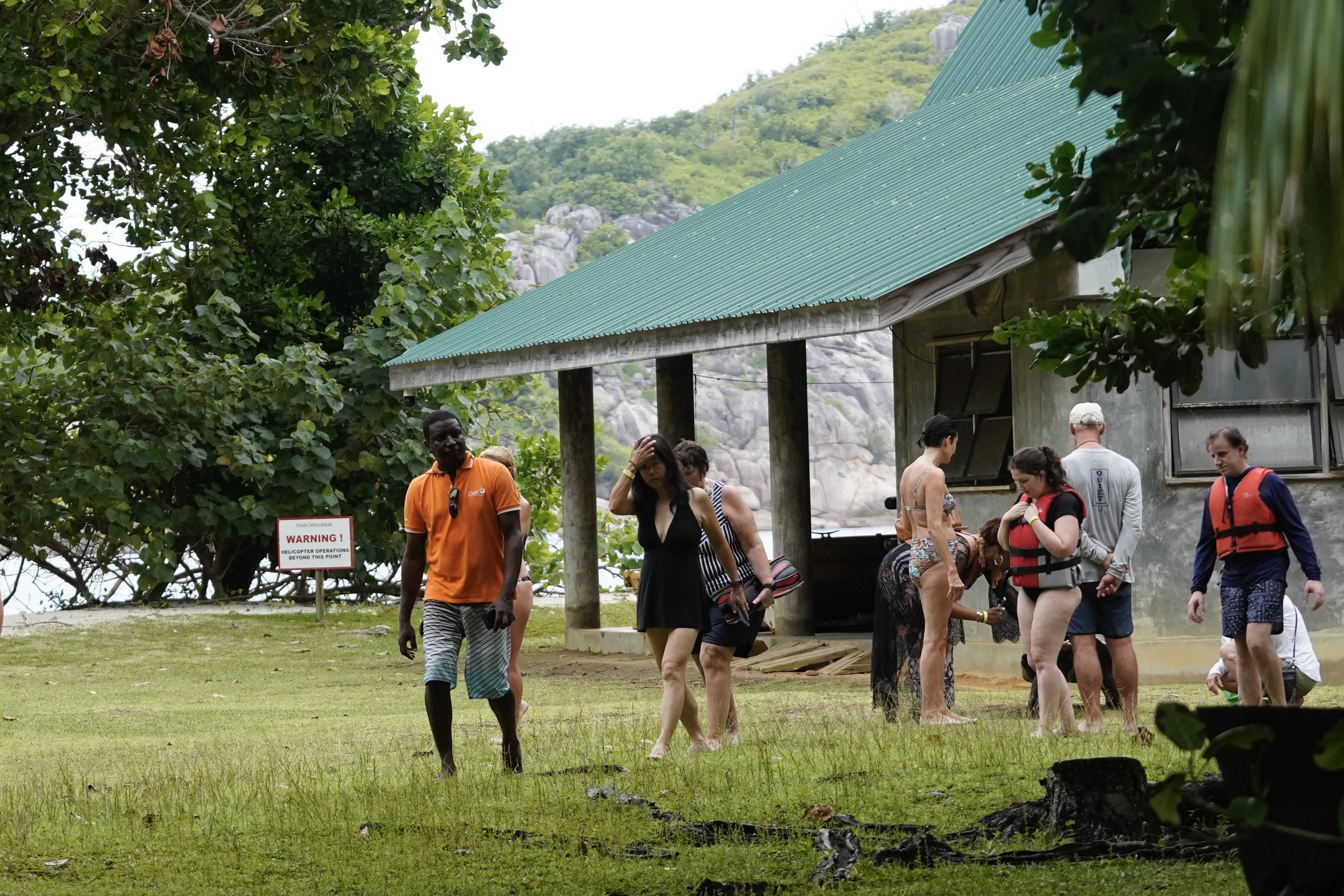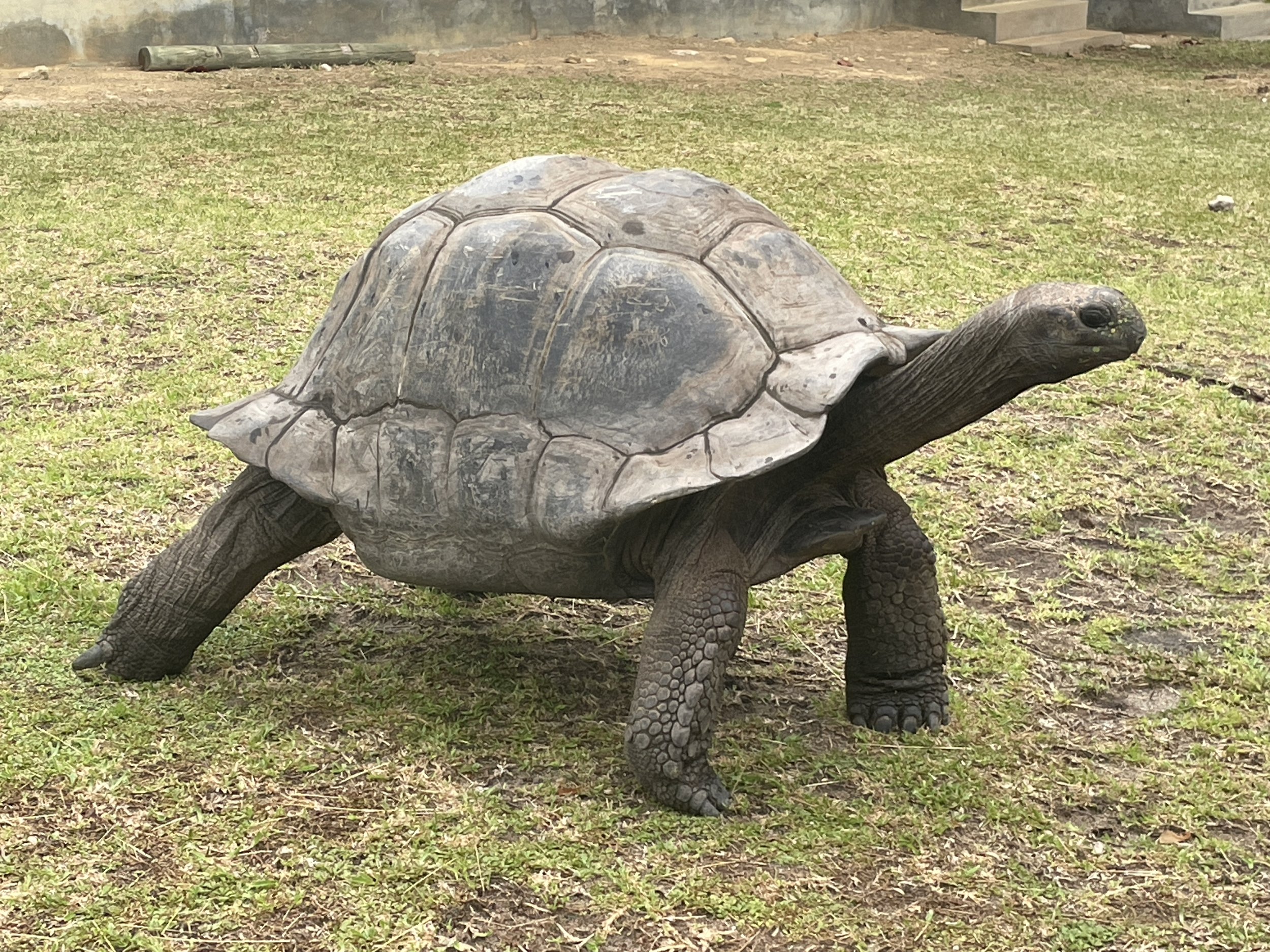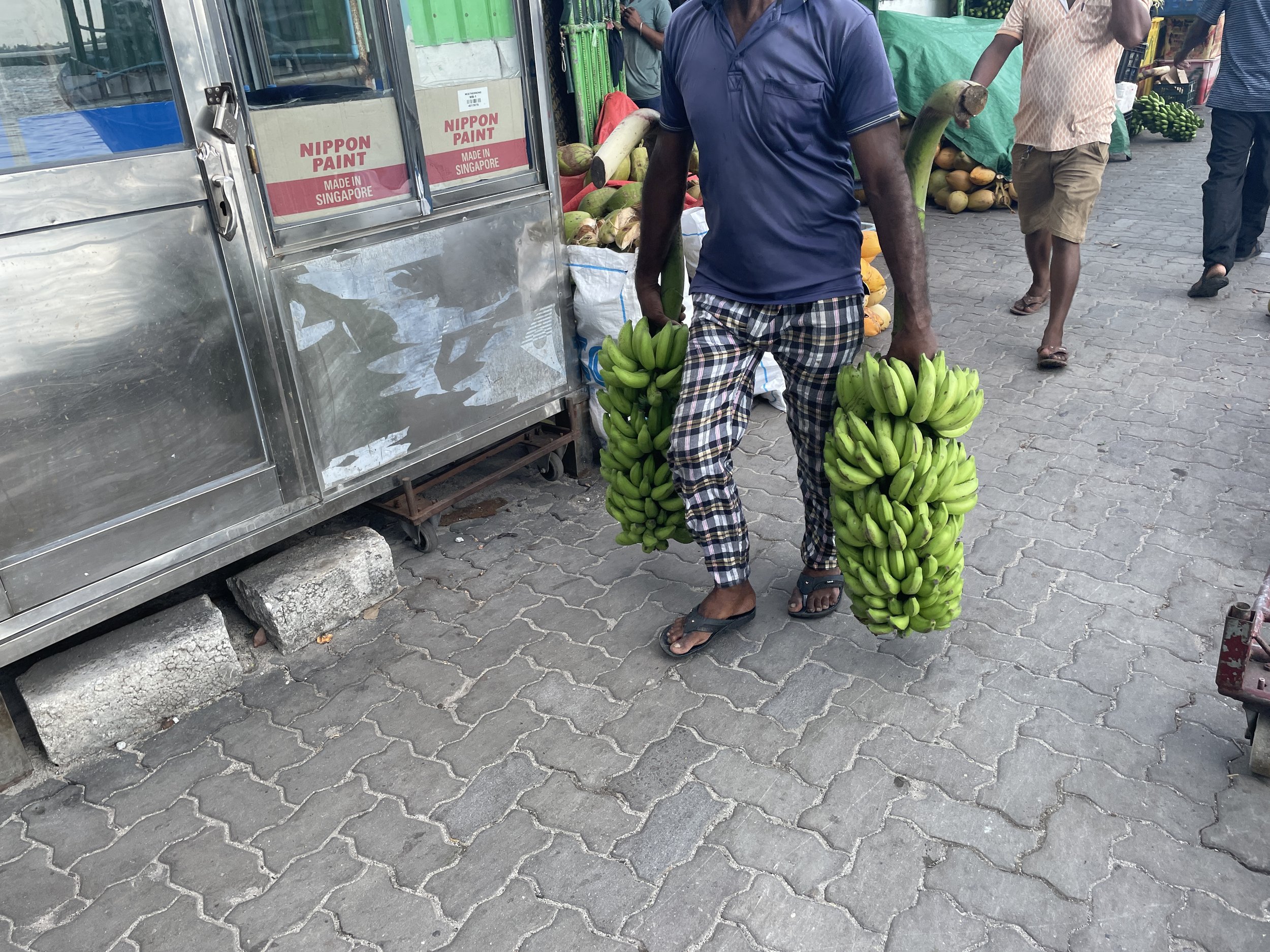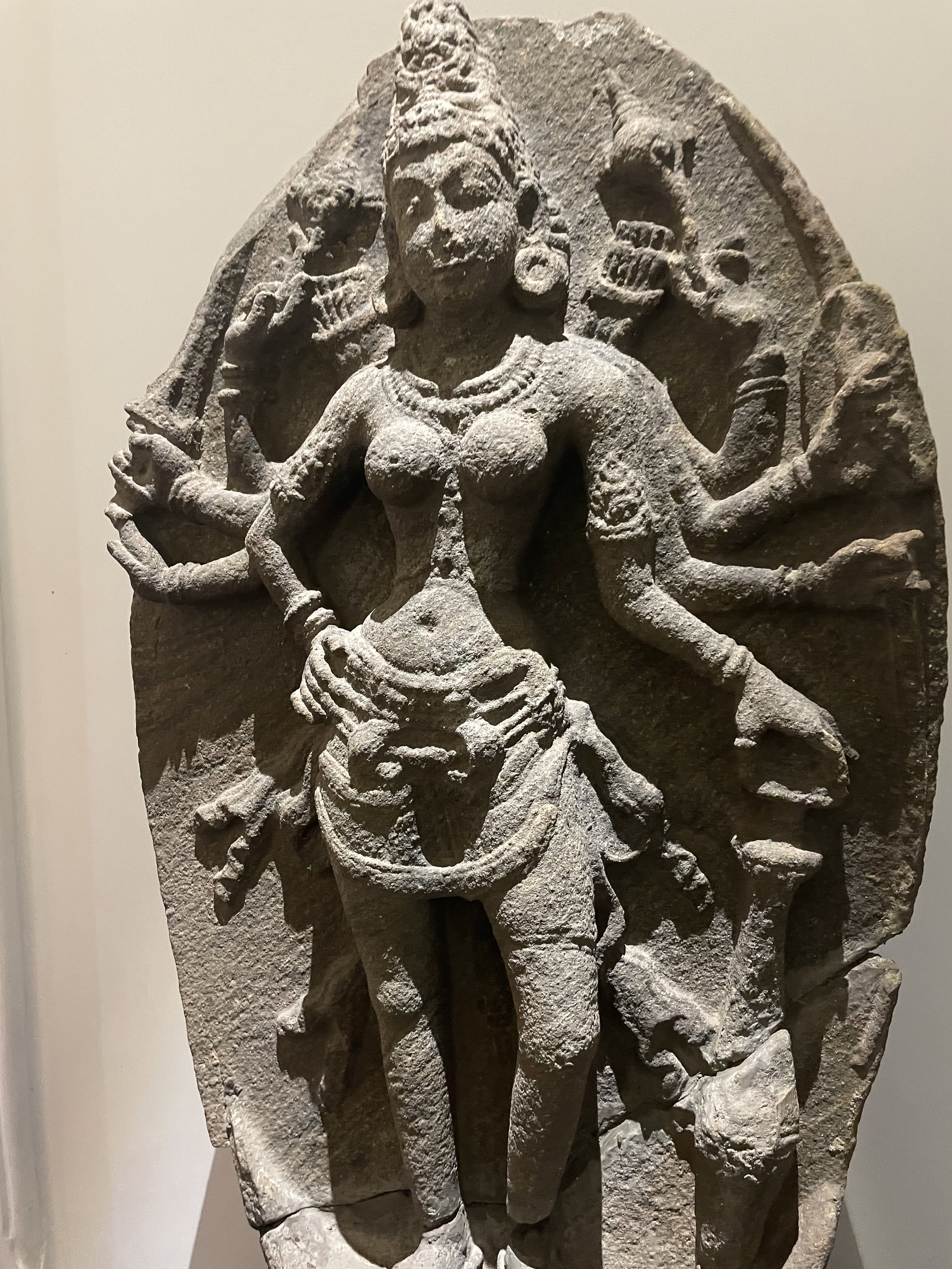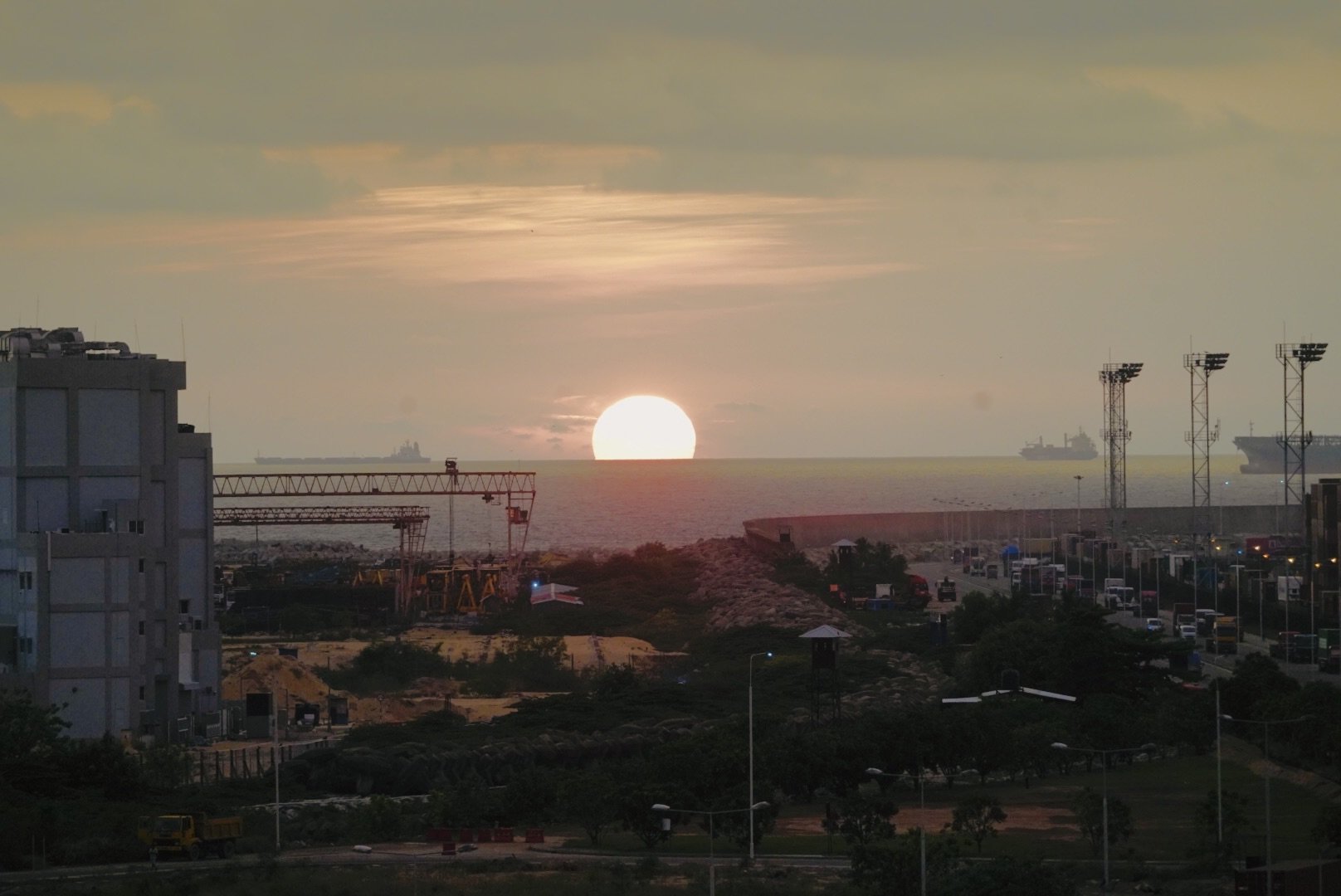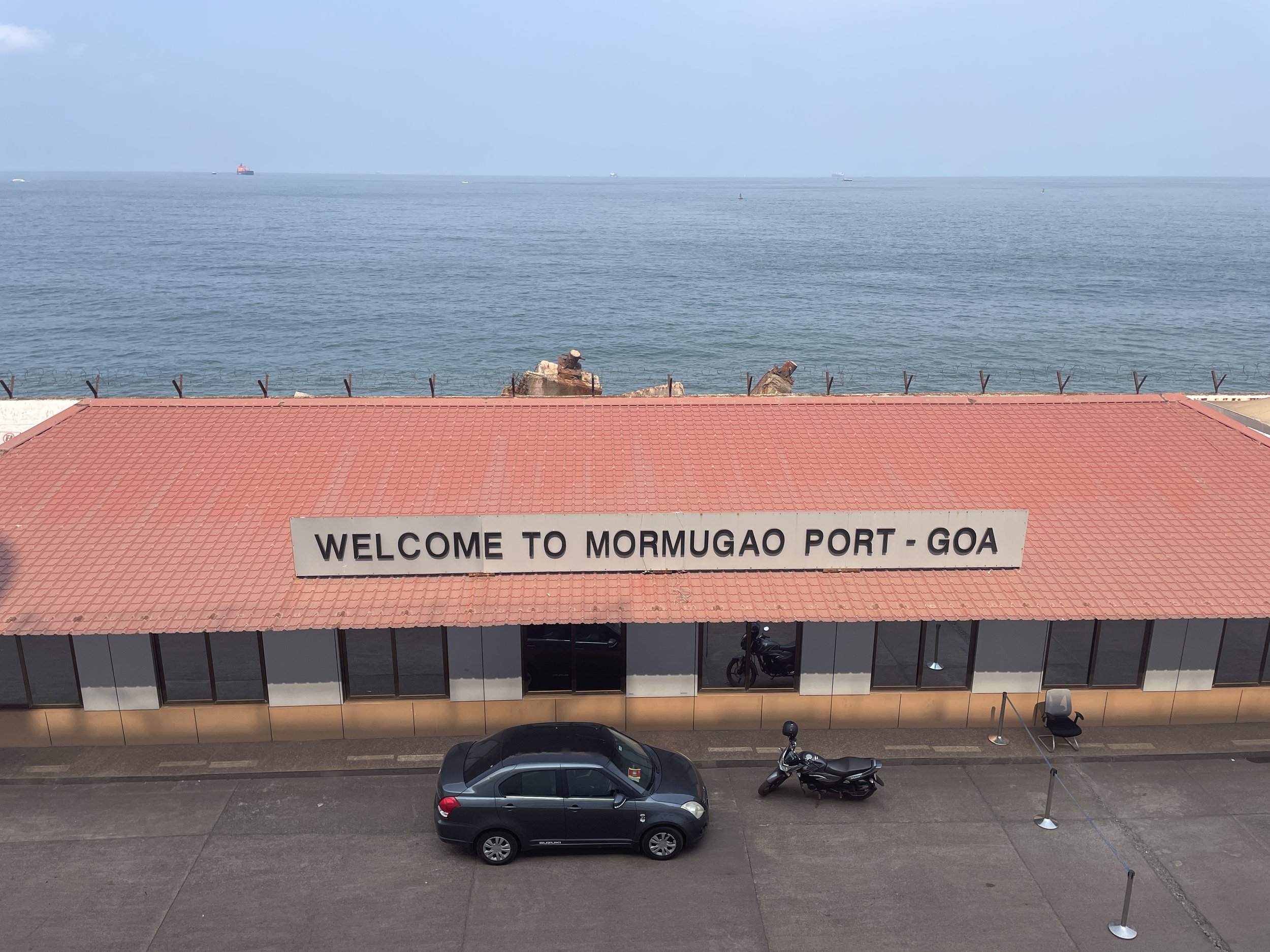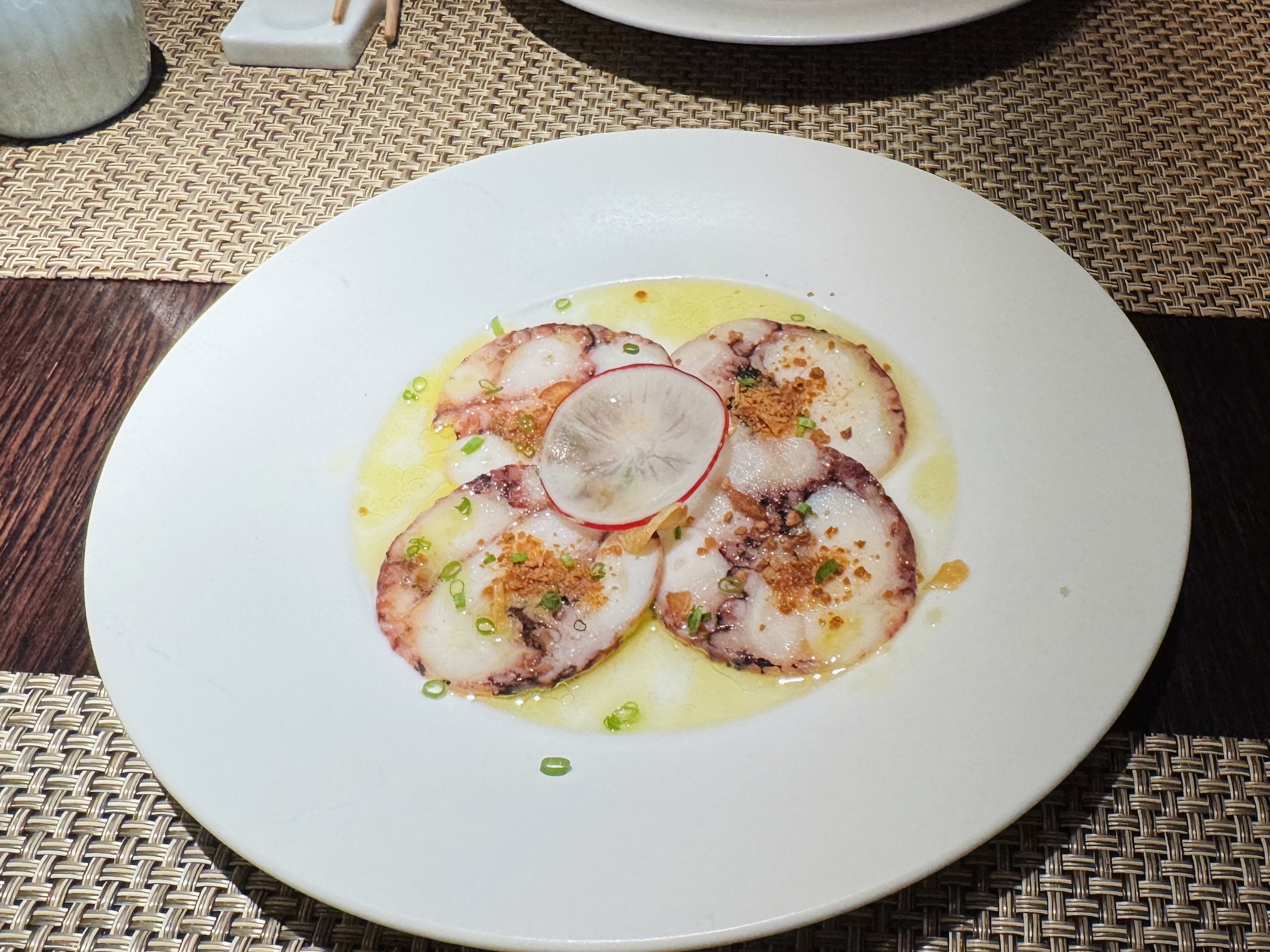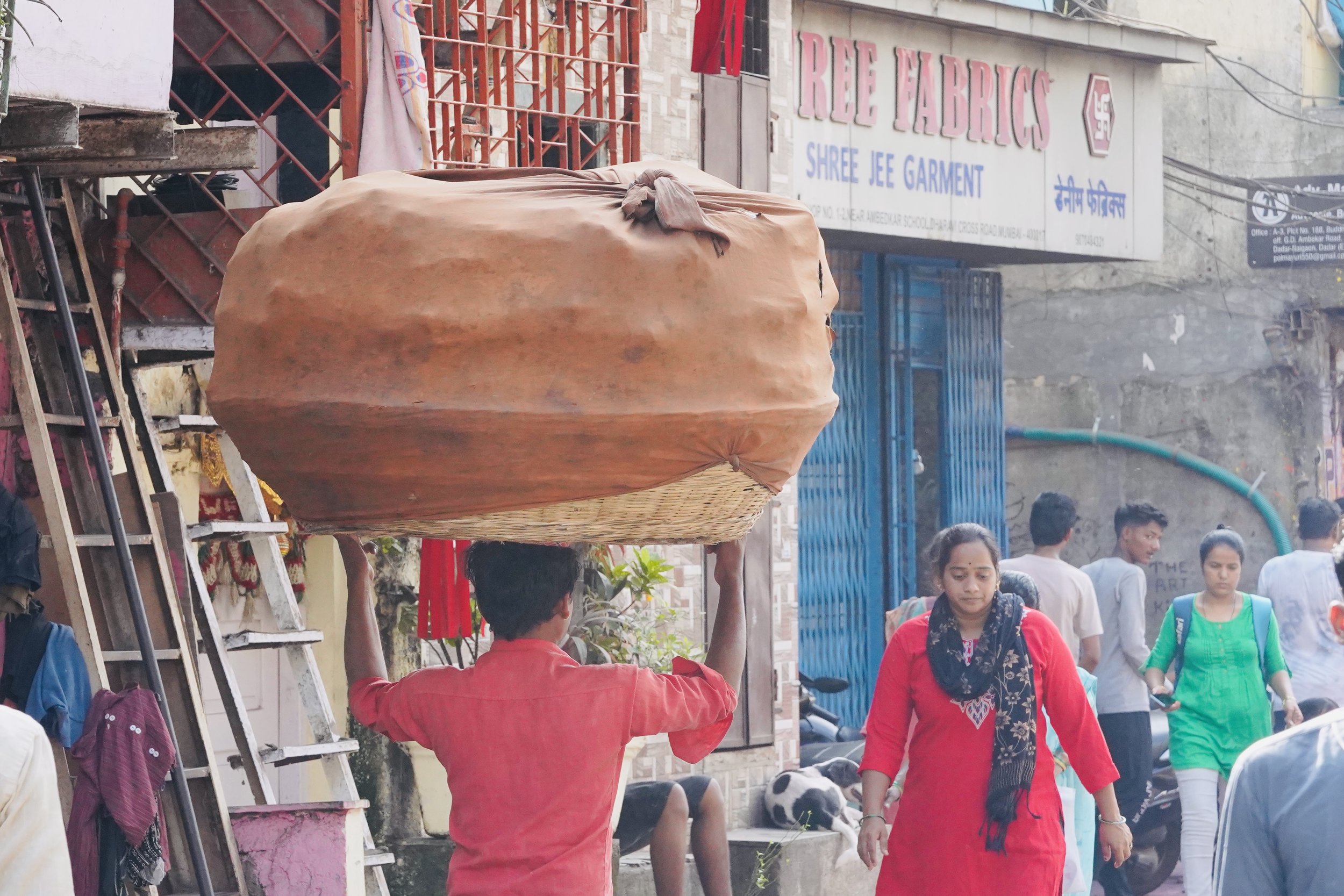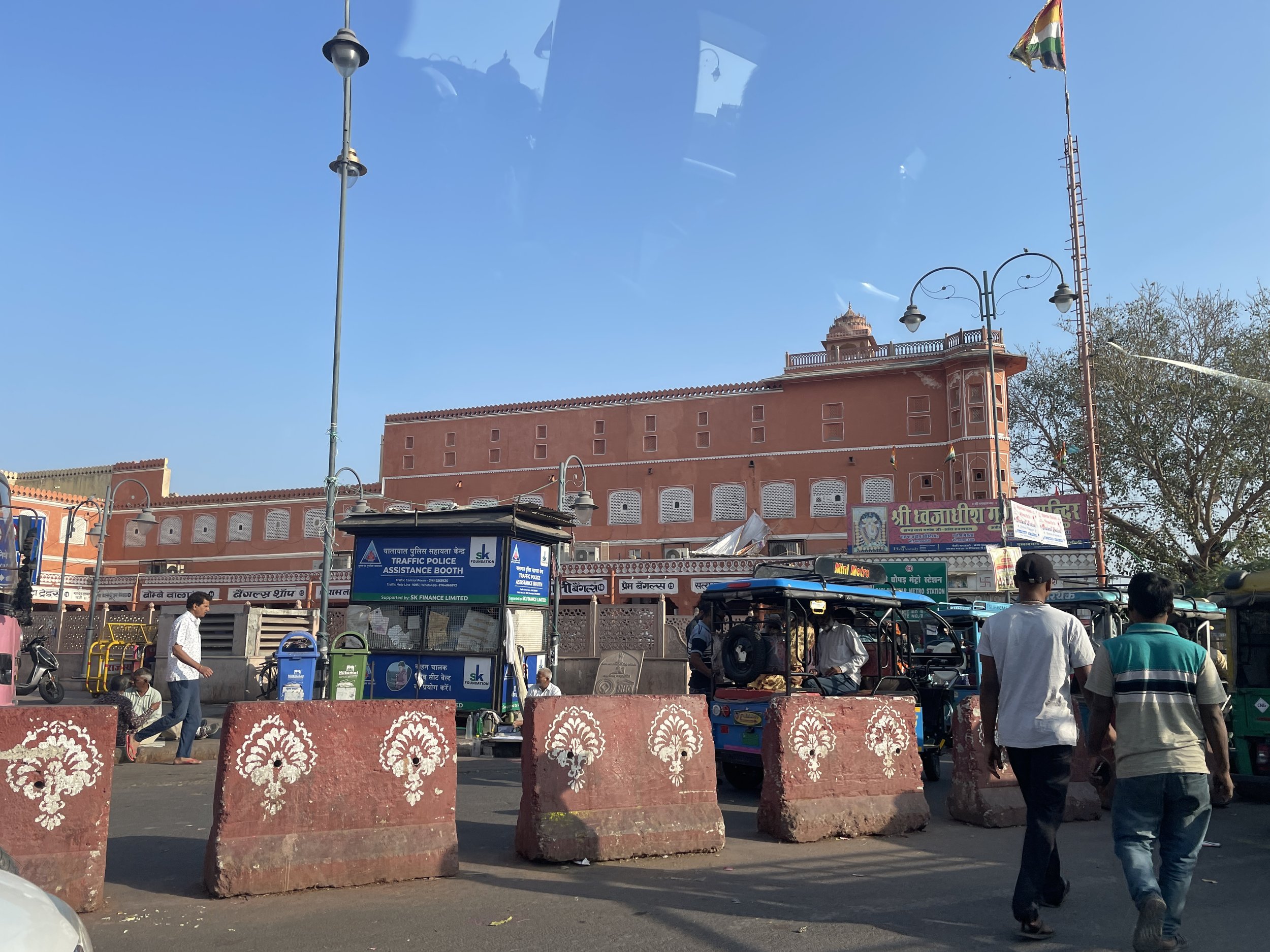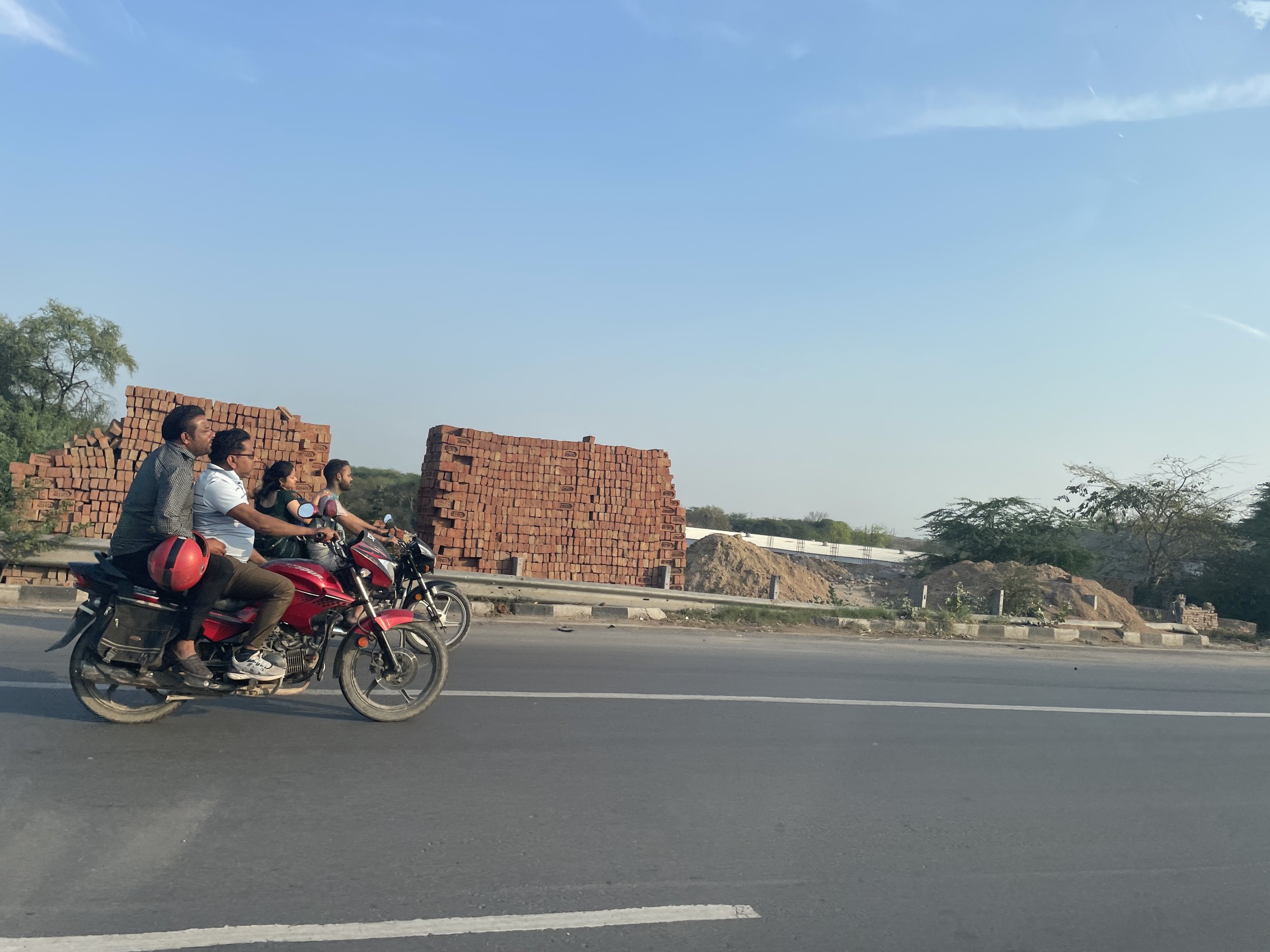Table Mountain, Cape Town 桌山,开普敦
April 11, 2025
We got up before sunrise,……
我们的邮轮在上午晚些时候抵达南非开普敦。。。
April 11, 2025
We got up before sunrise, hoping to catch a glimpse of the lighthouse at Cape Point, the southernmost tip of the continent. But it was too late—our ship had already sailed north. However, the coastal scenery, including Table Mountain bathed in the morning light, was magnificent.
Our ship docked in Cape Town, South Africa, late in the morning. Since we were assigned a working berth, the port provided a complimentary shuttle to the city center. We boarded the shuttle and once in the city, purchased a 3-day hop-on/hop-off bus pass to begin our exploration.
The weather was dry and pleasant—perfect for sightseeing. Cape Town immediately impressed us with its natural beauty and urban charm. Our first stop was the Table Mountain cableway. The line for standard tickets stretched out with an estimated two-hour wait, but we noticed that guests with “fast track” tickets—though double the price—could bypass the wait entirely. We opted for the fast track and were soon on our way up the mountain.
At the summit, we were greeted with absolutely breathtaking views. From that vantage point, we could see all the way to Robben Island, and the surrounding cityscape. We spent over an hour soaking in the panoramic scenery, taking photos, and appreciating the majesty of the moment.
After descending by cable car, we rejoined the hop-on/hop-off bus and continued our ride along Cape Town’s stunning coastline. Partway through the journey, a heavy fog rolled in, softening the scenery and creating a mysterious, moody atmosphere. Visibility dropped, but it added a unique touch to our coastal ride.
We eventually returned to the ship, where we enjoyed another delicious dinner at Umi Uma. To cap off the evening, a local dance troupe came aboard and performed a vibrant and energetic show, offering us a taste of South African culture before we sailed away.
桌山,开普敦
2025年4月11日
我们的邮轮在上午晚些时候抵达南非开普敦。由于今天我们的船首先停靠的是一个作业码头,到晩上才换到旁边的邮轮码头,港口特地为乘客安排了接驳车。我们搭乘接驳车前往最热闹的海滨中心,并购买了为期三天的观光巴士通票,开始探索这座美丽的城市。
今天的天气干燥宜人,蓝天白云,非常适合观光。开普敦给我们留下了深刻印象,既有自然美景,也有都市风情。我们的第一站是桌山缆车站。普通票排队时间大约需要两个小时,但我们发现如果购买快速通道票(虽然价格翻倍),就可以直接上山。于是我们选择了快速通道,节省了大量等待时间。
到达山顶后,眼前的景色令人叹为观止。山顶上有许多小路可以走,从高处可以远眺好望角、罗本岛以及四周的城市和海岸线。我们在山顶逗留了一个多小时,拍照留念,静静欣赏这壮丽的自然奇观。
之后我们乘坐缆车下山,重新登上观光巴士,继续沿着开普敦美丽的海岸线前行,也见识了开普敦最豪华的住宅区。途中突然一阵浓雾涌来,能见度迅速降低,原本清晰的风景变得朦胧神秘,也为旅程增添了一份特别的氛围。
我们最终返回邮轮,在最喜欢的Umi Uma日本餐厅再次享用了美味的晚餐。当晚,一支当地舞蹈团登船,为我们带来了一场充满活力的南非舞蹈表演。
Mossel Bay, South Africa 南非·莫塞尔湾
April 10, 2025
Today we anchored at Mossel Bay,……
April 10, 2025
Today we anchored at Mossel Bay, a charming coastal town nestled along South Africa’s renowned Garden Route. Several seals were playfully swimming around our ship.
Our excursion took us inland to the Garden Route Game Lodge for another safari experience. The drive itself was a highlight, with sweeping views of rolling hills and fynbos-covered plains—landscapes that define the natural beauty of this region.
During the game drive, we saw three lions resting under the sun in a separate enclosure, being fed a large cow—a reminder that this reserve operates more like a managed habitat than a wild safari. We also spotted two elephants, three powerful rhinos, and a variety of other animals including zebras, antelope, and exotic birds. While the scenery was peaceful and the surroundings picturesque, the wildlife encounters felt a bit underwhelming compared to other safaris we’ve had on this trip. It felt more like a large, open zoo than a true safari in the wild.
After the tour, we spent about 30 minutes strolling through the town. Though small, Mossel Bay left a pleasant impression—simple, clean, and peaceful, reminiscent of quaint towns we’ve visited in Europe or New Zealand.
南非·莫塞尔湾
2025年4月10日
今天我们在南非海滨小镇——莫塞尔湾抛锚停靠。我们的行程是前往内陆的花园大道狩猎保护区,再来一次野生动物观赏之旅。来非洲就是来看动物的,所以这几天每到一地都参加船上组织的野生动物观赏活动。保护区离码头近一个小时,沿途车窗外的景色令人陶醉,连绵起伏的丘陵与遍布芬博斯植被的原野,展现了这一地区独特的自然风貌。
有了昨天非常棒的野生动物探险,今天就不指望太多了。在园区内的游览过程中,我们看到了三只狮子,所在区域与其它动物分隔开来。它们在阳光下悠闲地享用着工作人员投喂的整头大牛。据说这头牛够它们吃一个多星期的。但很可惜的是这几头狮子都已失去自己猎物的能力,必须靠工作人员投喂。此外我们还看到两头大象和三头体型庞大的犀牛。保护区里还有许多斑马、羚羊和各种奇异鸟类等众多动物。但整体体验比起我们此行中其它几次野生动物之旅逊色很多,虽然也是坐着那种类似的十人一组的大吉普,却缺少那种惊喜与刺激,更像是在一个大型开放式动物园开着车兜风。
返程来到码头后,我们在莫塞尔湾镇中心短暂步行了约三十分钟。这座小镇虽不大,但街道干净整洁、氛围安静祥和,让人不禁联想到我们曾经走访过的欧洲或新西兰的小镇。
Pumba Private Game Reserve 彭巴私人野生动物保护区
April 9, 2025
Yesterday was another day at sea……
又是一天的海上行,。。。
April 9, 2025
Yesterday was another day at sea as our ship traveled from Richards Bay to Port Elizabeth, South Africa.
After breakfast, we set off from Port Elizabeth for a wildlife adventure at Pumba Private Game Reserve. The drive took about an hour and a half by coach, after which we transferred to specialized jeeps, ten guests per vehicle, to begin our safari.
Our journey began with a peaceful scene: two cheetah brothers lounging leisurely on the grass, allowing us to take photos at our own pace. Our guide today was fantastic—a seemingly shy young woman with an incredible eye for spotting wildlife.
Not long after, our guide excitedly pointed out a group of white lions in the distance. When we arrived, we were amazed to find nine lions gathered together, including several rare white lions.
Just as we were taking it all in, a dramatic moment unfolded—a white rhinoceros slowly approached from afar and astonishingly drove away all nine lions right before our eyes. It was a breathtaking, once-in-a-lifetime scene.
In addition to the cheetahs and lions, our guide led us to sightings of elephants, zebras, giraffes, hippos, and countless other animals.
We had delicious buffet lunch at the lounge. Today’s safari was truly the highlight of our African journey so far.
彭巴私人野生动物保护区
2025年4月9日
又是一天的海上行,我们的船从理查兹湾来到南非的伊丽莎白港。
早餐后我们从伊丽莎白港出发,开启了彭巴私人野生动物保护区(Pumba Game Reserve)的野生动物探险之旅。大巴载着我们一个半小时左右来到保护区,然后换乘十人一组的专用吉普车开始探寻。我们今天的向导非常棒,看上去是一位腼腆的姑娘,却有着惊人的眼力,能在第一时间看到别人看不到的东西,她带给了我们一次难以忘怀的经历!我们的旅程以一幅宁静的画面开始:两只猎豹兄弟悠闲地躺在草地上,让我们随意地拍摄。之后没多久向导兴奋地说远处有白狮子。当她带着我们来到狮子面前时,非常难得看到有九头狮子聚在一起,其中包括几头罕见的白狮子。而更没想到的是,一幕惊心动魄的场景展现在我们眼前:远处慢慢走来一头白犀牛,居然能将九头狮子驱赶走,一切都发生在我们眼前,令人震撼。除了猎豹,狮子之外,向导还带着我们看了大象,斑马,长颈鹿,河马和不计其数的各类动物。今天的探险可以说是这几天非洲之行中最棒的一次探险。
Richard’s Bay (2), South Africa, 理查兹湾
April 7, 2025
Today, we joined another tour to visit iSimangaliso Wetland Park,……
今天我们参加了另一项邮轮组团游,。。。
April 7, 2025
Today, we joined another tour to visit iSimangaliso Wetland Park, a UNESCO World Heritage Site known for its large population of hippos and Nile crocodiles. During the boat cruise on the estuary, we saw countless hippos lounging in the water and a few crocodiles basking along the banks.
While it was fascinating to observe these animals in their natural habitat, the experience felt a bit more relaxed and less thrilling compared to yesterday’s game drive in Hluhluwe–iMfolozi Park.
This afternoon, we say goodbye to Richard’s Bay and continue our journey.
iSimangaliso 湿地公园
2025年4月7日
今天我们参加了另一项邮轮组团游,前往著名的 iSimangaliso 湿地公园。这座公园是联合国教科文组织认定的世界遗产,以拥有大量的河马和尼罗鳄而闻名。
在红树林河口的游船过程中,我们看到无数只河马懒洋洋地泡在水中,还有一条鳄鱼在岸边晒太阳。能在自然环境中近距离观察这些野生动物,依然是一次难得的体验。
不过相比昨天在 Hluhluwe–iMfolozi 公园的惊喜与刺激,这次的湖上巡游显得平静、放松,少了几分紧张与惊艳。
傍晚,我们的船离开理查兹湾,继续我们的南非旅程。
Richard’s Bay (1), South Africa 理查兹湾, 南非
April 6, 2025
After three sea days, we arrived in Richard’s Bay,……
April 6, 2025
After three sea days, we arrived in Richard’s Bay, South Africa, in the morning, a coal transport port. Disembarkation required a face-to-face immigration and customs inspection, which went smoothly. We then boarded a shuttle bus into the city, where we were pleasantly surprised by how clean and modern Richard’s Bay was. The shopping mall we visited was as large and well-equipped as any mall in the United States—an impressive introduction to this small, beautiful city.
After a quick early lunch, we set off for Hluhluwe–iMfolozi Park, the second-oldest national park in the world after Yellowstone. This park is renowned for its successful conservation efforts, particularly for saving the southern white rhino from extinction.
Our 2+ hour game drive in the Hluhluwe section of the park was thrilling, breathtaking, and unforgettable. A male lion sat regally on the road, watching us as we passed by, while a mother lion and her cub played in the bushes nearby. One of the most dramatic moments was seeing an elephant chase a white rhino away—an intense and awe-inspiring sight.
In just a short game drive, we encountered four of Africa’s iconic Big Five: lion, buffalo, elephant and rhino except leopard. The close-up wildlife encounters made this one of the most memorable safari experiences we’ve ever had. Hluhluwe–iMfolozi Park truly lived up to its legendary status.
Hluhluwe–iMfolozi 公园
2025年4月6日
离开东非的坦桑尼亚,经过三天的海上航行,我们于清晨抵达南非的理查兹湾(Richard’s Bay)。早餐后南非的海关工作人员上船来与所有乘客进行一对一面试,过程非常顺利。随后我们搭乘邮轮提供的免费接驳巴士前往市区,对理查兹湾的整洁与现代化感到惊喜。这座城市虽然不大,却井然有序,绿树成荫。免费大巴送我们到市区的购物中心,它与美国的大型商场一样宽敞、设备齐全,给我们留下了极好的第一印象。
回到船上简单吃过早午餐后,我们便出发前往Hluhluwe–iMfolozi 公园。这是世界上仅次于黄石公园的第二古老国家公园,因成功拯救南方白犀牛免于灭绝而闻名于世。
我们在公园 Hluhluwe 区域进行了一次超过两小时的野生动物观赏之旅,过程惊险刺激、令人屏息、难以忘怀。进公园不久就遇到一只雄狮从草丛中走岀来,威风凛凛地在马路边爬下,注视着我们的车辆缓缓驶过;不远处,狮妈妈与小狮子在灌木丛中嬉戏玩耍。而最令人震撼的一幕,是看到一头大象发威将一只白犀牛驱赶离开——场面紧张而震撼人心。
在短短的行程中,我们近距离看到了非洲标志性的“非洲五霸”中的四种:狮子、水牛、大象和犀牛,唯独没见到豹子。还有不计其数的白斑羚, 黑斑羚,各种鸟类等等。Hluhluwe–iMfolozi 公园果然不负盛名,实至名归。如此近距离的野生动物体验,让这次狩猎车之旅成为我们最难忘的非洲野生动物探险之一。
Zanzibar, Tanzanian 桑给巴尔
April 2, 2025
After an overnight sail, we anchored off the coast of Zanzibar……
在夜间航行一夜之后,
April 2, 2025
After an overnight sail, we anchored off the coast of Zanzibar, a Tanzanian island steeped in history. Once a major hub for the spice and slave trades, Zanzibar today is known for its cultural richness and stunning architecture. At its heart lies Stone Town, a UNESCO World Heritage Site and a fascinating melting pot of Arab, Persian, Indian, African, and European influences.
Our first stop of the ship-organized tour was the Anglican Cathedral, built atop what was once the largest slave market in East Africa. After the abolition of slavery, the cathedral was erected here as a symbol of redemption. Walking through the underground slave chambers, where countless lives were once held in captivity, was a deeply disturbing and emotional experience—a sobering reminder of a dark chapter in human history.
Next, we strolled through the narrow alleys of Stone Town, marveling at the intricate carved wooden doors, most of which reflected strong Indian design influences. Unfortunately, two of Stone Town’s most iconic historical buildings—the House of Wonders and the Sultan’s Palace—were closed for renovation.
As we continued, we visited the Old Fort (Ngome Kongwe), the oldest building in Stone Town, constructed by the Omani Arabs in the 17th century. Over time, it served as a fortress, prison, and later, an amphitheater. Today, its inner courtyard houses local artisans selling crafts and souvenirs.
We ended the walk at Forodhani Gardens, a popular seaside promenade. Then we enjoyed a brief rest and refreshments at the elegant Zanzibar Serena Hotel, soaking in the ambiance of the waterfront.
On the way back to the cruise terminal, we made a short stop at Darajani Market, a vibrant local market bustling with vendors selling everything from fresh produce and spices to fish and household goods. It was a fitting end to a culturally rich and reflective half-day tour through the historic heart of Zanzibar.
Connie was too tired to go out for dinner, so Chenggang ordered room service. Our butler handled everything, from placing the order to setting up the table. The food was delicious. After dinner, there was another white party, but as usual, we simply watched as observers.
桑给巴尔石头城徒步游
2025年4月2日
在夜间航行一夜之后,我们的邮轮在桑给巴尔(Zanzibar)岛外海抛锚。这座坦桑尼亚的海岛拥有悠久的历史,曾是香料和奴隶贸易的重要枢纽。其中最具代表性的是石头城(Stone Town),一处被联合国教科文组织列为世界文化遗产的历史城区,融合了阿拉伯、波斯、印度、非洲和欧洲多种文化元素。
我们的第一站是圣公会大教堂与原奴隶市场遗址。这座教堂正是建立在曾经东非最大的奴隶市场旧址之上。奴隶制被废除后,这座教堂作为“救赎”的象征而建。在地底下参观那些曾经关押奴隶的地牢,让人心情沉重、震撼不已,是对人类历史上一段黑暗时期的警醒与反思。
随后,我们穿行在石头城曲折狭窄的小巷中,欣赏两侧精美的雕花木门,其中大多展现出浓厚的印度风格。令人遗憾的是,石头城两座最具代表性的历史建筑——奇迹之屋(House of Wonders)与苏丹王宫正处于整修期间,无法入内参观。
继续前行,我们参观了古堡(Ngome Kongwe),这是石头城最古老的建筑,由阿曼阿拉伯人于17世纪所建。它曾作为防御工事、监狱,后来还被用作露天剧场。如今,其内部庭院里有不少当地手工艺人设摊售卖工艺品与纪念品。
我们最后来到了福罗达尼花园(Forodhani Gardens),这是一处临海的热门休闲广场。随后,我们在漂亮的桑给巴尔塞丽娜酒店(Zanzibar Serena Hotel)稍作休息,享用茶点,感受海风拂面的惬意时光。
返回邮轮码头途中,我们在达拉贾尼市场(Darajani Market)短暂停留。这个充满活力的本地市场人声鼎沸,摊位上琳琅满目的商品从新鲜蔬果、香料到海鲜、日用品应有尽有。半天的组团游算是完成了今天的桑给巴尔到此一游。
Mombasa, Kenya 蒙巴萨一日游
April 1, 2025
We started the day feeling anxious, nervous, and a little fearful……
带着焦虑、紧张和有些恐惧心理我们开始了。。。
April 1, 2025
We started the day feeling anxious, nervous, and a little fearful—uncertain of what to expect. The story actually began yesterday. During one of the ship-organized tours to central Mombasa, a fellow passenger was robbed near the famous Mombasa Tusks. Several young men surrounded him, pushed him to the ground, and snatched his phone. Thankfully, he wasn’t physically hurt, but the incident was a sobering reminder to everyone onboard to stay alert and prioritize safety.
Today, we joined a guided tour arranged by the ship to explore Mombasa island, the second-largest city in Kenya. Our first stop was the iconic Mombasa Tusks on Moi Avenue, built in 1952 to commemorate Queen Elizabeth’s visit—ironically, the very place where the robbery took place the day before. The tour company made sure we stayed together as a group, with a guide leading the way and an assistant at the back to ensure no one lagged behind. As we stepped off the bus, we noticed several armed policemen patrolling the street. An armed policewoman even accompanied our group throughout the stop. It was quite a scene.
Right next to the monument, we wandered through Uhuru Gardens, where hundreds of fruit bats dangled from massive mango trees—a surreal and unexpected sight.
Then we strolled through a park where several massive, centuries-old baobab trees stood. It is also a place for locals relaxing and gathering. From there, we watched in amazement as two ferries packed with passengers sailed from the terminals—offering us a vivid glimpse into the rhythm of daily life in Mombasa.
From there, we visited Fort Jesus, a formidable 16th-century Portuguese fort that now houses a museum. Walking through its thick stone walls, past ancient cannons, we learned about Mombasa’s layered colonial history.
Afterward, we strolled into the Old Town. Compared to other historic towns we’ve visited, this one felt less charming and didn’t leave as strong an impression on us.
By midday, we made our way to the Tamarind Restaurant on Mombasa’s mainland, where we enjoyed a lovely buffet brunch. The delicious dishes and beautiful view provided the perfect refuel for the afternoon.
Later, we visited Haller Park, a reclaimed limestone quarry turned lush nature reserve. One of the highlights was feeding giraffes—watching them gently pluck pellets from our hands with their long, curious tongues was magical. We also saw two hippos lounging on the grass while monkeys chased each other and two gemsboks stood nearby, calm and unbothered. Around 4 p.m., a worker came to feed the hippos, adding a fun end to our visit.
Mombasa, like many developing cities, has its challenges. When a large group of foreign tourists appears in a densely populated local area, it can draw attention—sometimes from opportunists. But that’s part of traveling: stepping out of your comfort zone and managing the risks.
The moment we returned to the ship, we signed up for another guided tour for tomorrow. No more self-guided adventures—at least for now.
蒙巴萨一日游
2025年4月1日
带着焦虑、紧张和有些恐惧心理我们开始了今天的蒙巴萨(Mombasa)一日游。故事其实始于昨天,邮船组团游中一位游客在著名的蒙巴萨象牙门附近拍照时被十几个年轻人(据媒体报道,有五十人但船上目击人称没这么人参与)围攻并推倒在地,手机被抢走。还算幸运,他身体并无大碍,但这起事件给船上的每一个人都敲响了警钟——肯尼亚这里的治安不好,游客必须保持警惕,注意人身安全。
我们今天也参加了邮轮安排的组团游,参观位于蒙巴萨岛上的肯尼亚第二大城市蒙巴萨。第一站就是位于莫伊大道上的地标性建筑——蒙巴萨象牙门。这座纪念碑为纪念伊丽莎白女王的来访而建于1952年。昨天的抢劫事件就发生在这里。今天旅行公司特别强调大家必须成团行动,安排了一名导游带队,还有一位助理压阵,负责照看是否有人掉队。我们一下大巴就注意到街上有几位持枪警察巡逻,一位持枪的女警甚至一路跟随我们,这一幕令人印象深刻。
纪念碑旁是乌呼鲁花园,我们漫步其中,抬头望去,成百上千只果蝠倒挂在巨大的芒果树上,场面诡异,令人难忘。
然后我们漫步通过一座公园中,几棵巨大的、已有数百年树龄的猴面包树巍然矗立。这里也是当地人休闲聚会的好去处。
接着我们前往了耶稣堡(Fort Jesus),这座建于16世纪的葡萄牙堡垒如今是一座博物馆。我们穿行于厚重的石墙之间,经过古老的大炮,了解了蒙巴萨复杂的殖民历史。随后,我们漫步进入了老城区。相比我们曾经造访过的其他历史古镇,这里的魅力略显逊色,未能给我们留下特别深刻的印象。
中午时分,我们前往位于蒙巴萨大陆上的塔玛琳餐厅(Tamarind Restaurant),享用了一顿丰盛的自助午餐。美味的佳肴与餐厅迷人的海景为我们注入了新的能量,迎接接下来的行程。
下午我们参观了哈勒公园(Haller Park),这是一个由废弃石灰岩采石场改建而成的自然保护区。喂食长颈鹿是今日的亮点之一,看它们用长而灵巧的舌头温柔地从我们手中取食,令人感到无比神奇。我们还看到两只河马慵懒地站在草地上,猴子们在一旁追逐嬉戏,而两只大羚羊则悠闲地站在不远处,独自享受着宁静。下午四点左右,一名工作人员前来给河马喂食,结束我们的行程。
像许多发展中国家一样,蒙巴萨也面临不少挑战。当一大群外国游客突然出现在人口密集的本地区域时,的确可能引来一些“机会主义者”的注意。但这也是外出旅行的一部分,不管去哪里,风险总是存在,小心一点,有点街头智慧。
跟团游结束后安全回到船上后的第一时间,我们就报名参加了明天的另一个邮轮组团游。原本打算明天是自己到处走走的,现在放弃这个想法,不再准备自由活动了——至少暂时不会了。
Kenya Tsavo East National Park 肯尼亚察沃东国家公园
March 31, 2025
We spent two more days at sea……
经过二天的海上行,
March 31, 2025
We spent two more days at sea. During these sea days, Chenggang attended golf lessons taught by a PGA instructor and participated in various activities offered throughout the ship. It was the perfect time for us to relax and recharge while enjoying everything the ship had to offer.
After two days at sea, we arrived in Mombasa, the largest port and the second-largest city in Kenya.
Chenggang joined a full-day safari to Tsavo East National Park—one of Kenya’s oldest and largest wildlife reserves—for a 12-hour adventure. We woke up early and had a continental breakfast at 5:30 a.m. However, due to a delay in the ship’s clearance by local authorities, the shore excursion started about 30 minutes behind schedule.
Our group consisted of five people packed into a classic safari Land Cruiser, part of a convoy of 11 vehicles from the ship. The three-hour drive to the park offered us a fascinating glimpse into Kenya’s rural countryside.
Right before entering the park, our group made a pit stop at a tourist center that included gift shops and a café. Suddenly, loud noises coming from a tree behind the building caught our attention. To our amazement, we saw a large colony of Village Weavers, with hundreds of birds busily constructing their intricate nests. Each nest, coarsely woven from strips of grass and leaves, hung gracefully from branches and featured a distinctive downward-facing entrance. It was our first time witnessing this fascinating natural wonder, and we were thoroughly captivated by the spectacle.
As we rolled through the vast, open plains, Tsavo East unveiled its natural wonders. We saw zebras standing elegantly against the golden grasslands and towering giraffes browsing quietly in the distance. The park’s famous “red elephants,” their skin stained by the iron-rich soil, created a stunning contrast with the dry earth and blue sky. Two elephants fighting with tusks was another highlight. A giant hippo was bathing in the pond.
We encountered abundant wildlife up close along the way, including Red-billed Queleas, Herons, Gazelles, Impalas, Ostriches, Agama Lizards, Secretary Birds, Antelopes, and many others. Although we didn’t come across any predators—no lions or leopards this time—the absence of big cats didn’t diminish the wild’s magic in the slightest.
Zebra
Birds
Giraffe
Ostrich
Antelopes (Gerenuk, Hartebeest )
Midway through the journey, we stopped at Ashnil Aruba Lodge for a buffet lunch. Though we didn’t spot any animals at the waterhole during our break, the meal and brief rest were a welcome pause from the heat and dust.
The drive back was long and just as rugged, but we were rewarded with sightings of even more elephants. Near a pond close to the park gate, a magnificent red elephant slowly approached us, putting on a final, graceful performance as if to bid us farewell.
Tsavo East had offered us an authentic glimpse into nature’s raw beauty—an experience impossible to replicate in any zoo or wildlife documentary. Yes, the roads were bumpy, the air dusty, and the sun relentless, yet the excitement and wonder of our adventure easily outweighed any discomfort. This was the essence of a true safari—wild, untamed, and absolutely unforgettable.
In the evening, a local performance group treated us to a vibrant folkloric show, showcasing the rich cultural tapestry and artistic expressions of Mombasa through music, dance, and colorful costumes. It was an unforgettable experience.
肯尼亚察沃东国家公园一日游
经过二天的海上行,昨天我们来到肯尼亚第二大城市,最大海港Mombasa。今天我们踏上了一次前往察沃东国家公园(Tsavo East National Park)的野生动物观赏之旅。这里是肯尼亚最古老、面积最大的国家公园之一,这段十二小时的草原之行令人终生难忘。
清晨五点半,船上的餐厅特地为我们这些即将早早出发的乘客准备了简单早餐。由于船只通关手续稍有延误,岸上行程比原计划晚了大约半小时才得以启程。
来自邮轮的乘客每五,六人一辆车,总共十一辆四驱越野车组成了一支浩浩荡荡的探险车队。沿途尘土飞扬,道路颠簸不平,烈日高照,但旅途中的兴奋与期待早已掩盖了所有的不适。这就是我们梦寐以求的非洲野生动物之旅——原始、真实,令人震撼。
随着车队深入辽阔的平原,察沃东渐渐展现出它壮丽的自然风貌。斑马在草原中优雅矗立,远处的长颈鹿静静地仰望天空,仿佛画中走出的生灵。我们甚至幸运地目睹了两头大象激烈地用象牙对抗,但可惜照片聚焦有点模糊。而最引人注目的,莫过于这里著名的“红象”——它们身上覆盖着富含铁质的红土,宛如披上一层铜红色的盔甲,在干燥的大地与湛蓝天空之间格外醒目。
虽然此次未能目睹狮子或花豹等猛兽的身影,但这片原野的宁静与神秘丝毫未减其魅力。
中午时分,我们在阿什尼尔阿鲁巴旅馆(Ashnil Aruba Lodge)稍作停留,享用了一顿丰富的自助午餐。虽然在用餐期间水塘边未见太多的动物现身,但短暂的休息让我们在酷热与尘土间得到了宝贵的喘息机会。
返程同样颠簸漫长,但幸运之神依旧眷顾我们。就在靠近公园入口处的水塘边,一头美丽的红象缓缓走来,仿佛在为我们上演一场告别演出。这温柔而庄重的一幕,让我们觉得今天这趟非洲草原之旅再怎么辛苦也值了。
Mahé Island, Seychelles 马埃岛, 塞舌尔
March 28, 2025
Today we had the chance to explore Victoria,……
今天,我们有机会探索了维多利亚,。。。
March 28, 2025
Today we had the chance to explore Victoria, the charming capital of Seychelles — and one of the smallest capital cities in the world.
We began our day with a walk from the port under the blazing tropical sun. Our first stop: the Botanical Gardens. The short distance felt much longer in the heat and humidity, but the lush greenery and towering coco de mer palms made the effort worthwhile.
We strolled through shaded paths, soaking in the tranquil atmosphere. Feeding the giant tortoises was definitely the highlight, and we even spotted a fruit bat tucked beneath a palm leaf — an unexpected surprise!
Next, we made our way to the Sir Selwyn Selwyn-Clarke Market, a lively hub full of colorful stalls, fresh tropical fruits, aromatic spices, and handmade souvenirs. From there, we continued on to the Arul Mihu Navasakthi Vinayagar Temple, its vibrant walls and intricate carvings standing out beautifully in the midday light.
On our way back, we passed by the city’s iconic Clock Tower, a miniature replica of London’s Big Ben, and stopped for a quick photo before calling it a day.
By the time we wrapped up our sightseeing, we were sweaty, exhausted, and grateful for the ship’s shuttle bus waiting in the city center to take us back. After a refreshing lunch onboard, we retreated to our cabin for what was meant to be a quick rest — but turned into a well-earned two-hour nap.
马埃岛, 塞舌尔
2025年3月28日
今天,我们有机会探索了维多利亚(Victoria),这座迷人的小城不仅是塞舌尔的首都,也是世界上最小的首都之一。
我们从邮轮码头出发,在炽热的热带阳光下步行前往植物园。虽然距离不远,但在高温和潮湿的天气下,走起来格外吃力。但公园内,绿树成荫,郁郁葱葱,尤其是那高耸的海椰子树让人印象深刻。我们沿着林间小道悠闲漫步,感受着宁静的氛围。给巨型陆龟喂食成了今日的亮点,途中我们还意外地在棕榈叶下发现了一只果蝠,让人惊喜不已。
接着我们前往Sir Selwyn-Clarke 市场,这里热闹非凡,摊位上摆满了色彩缤纷的水果、香料与手工艺品,充满本地风情。随后,我们参观了阿鲁·米胡·纳瓦萨克提·维那亚加尔神庙(Arul Mihu Navasakthi Vinayagar Temple),它那鲜艳的墙面与精美的雕刻在正午的阳光下格外醒目。
返程途中,我们路过了维多利亚的地标——钟楼(Clock Tower),这是一座伦敦大本钟的微型复制品。我们在此稍作停留,拍了几张照片。
当我们结束一天的观光时,已是汗流浃背,疲惫不堪,还好邮轮公司安排的接驳车就在市中心等着我们返回船上。登船后享用了一顿清爽的午餐,我们回到船舱想稍微休息一下,结果这一躺就是两小时午睡,实在太需要了。
Praslin&La Digue, Seychelles 普拉兰岛和拉迪格岛, 塞舌尔
March 27, 2025
We spent two relaxing days at sea,……
在海上度过了两天宁静的航行后,。。。
March 27, 2025
We spent two relaxing days at sea, enjoying the many amenities offered on the ship. A typical sea day began with breakfast at the Market Place, accompanied by a latte and cappuccino. Afterwards, we would either head to the gym or take a walk around Deck 7.
At 9:30 a.m., sometimes, Chenggang attended a golf lesson, then joined Connie at 10:00 a.m. for a 45-minute lecture on destinations. During the 15-minute break before the next lecture at 11:00 a.m., we would stop by the Bistro on Deck 6 for coffee and snacks. After the second lecture, most likely on international fair and geopolitics, we typically enjoyed a buffet lunch at the Marketplace or dined at The BeefBar.
Our afternoons usually included a presentation on art performance at 1:30 p.m.. This was followed by a dance lesson at 2:30 p.m. and an art class at 3:30 p.m.—we would join one or sometimes both, depending on our energy levels.
After two peaceful days at sea, our ship finally anchored off Praslin Island, one of the sparkling gems of Seychelles. From there, we boarded a catamaran for an exciting day of island-hopping.
Our first stop was the nearby, privately owned Grande Soeur (Big Sister Island). We went ashore and hiked across the island to reach the beach on the other side — and what a beach it was. It was truly one of the most beautiful stretches of white sand we’ve ever set foot on. Along the way, we spotted crabs, tortoises, and a graceful white-tailed tropicbird soaring above.
After exploring, we swam and snorkeled our way back to the catamaran through crystal-clear waters.
Next, we headed to Coco Island, a tiny marine paradise known for its snorkeling. Unfortunately, the weather didn’t cooperate. Not long after we entered the water, the crew called everyone back aboard due to changing conditions. As soon as the last person was out of the water, the rain began — we felt lucky to have made it out just in time.
The catamaran then brought us to La Digue, a laid-back island famous for its car-free roads and relaxed vibe. From there, we were tendered back to the ship — just in time for a big, late lunch onboard. It was much needed after a morning filled with sun, sea, and adventure.
But our day wasn’t over yet.
In the late afternoon, Chenggang headed back out again alone, this time to visit one of the most beautiful beaches in the world — the legendary Anse Source d’Argent. With its surreal granite boulders, powdery white sand, and turquoise waters, it was every bit as magical as we imagined.
He made it back to the tender boat just in time — in fact, he was the last passengers to board before it pulled away from the island. What a perfect ending to an unforgettable day of island adventures in paradise.
Our cruise ship was repositioned third times in a day to dock in Mahe Island. Tomorrow is a disembarking and embarking day. We will stay for the next segment. After dinning at The Waterside, we enjoyed 4-hand Piano Spectacular at the Cove.
普拉兰岛、拉迪格岛, 塞舌尔
2025年3月27日
在海上度过了两天宁静的航行后,我们的邮轮从亚洲来到非洲,停泊在了塞舌尔的明珠之一——普拉兰岛(Praslin Island)外海。从这里我们乘坐接驳艇到岸上,然后我们登上了一艘双体船,开启了令人兴奋的跳岛之旅。
我们的第一站是附近私人拥有的大姐妹岛(Grande Soeur,又称Big Sister Island)。我们先登上岛,在岛上光着脚踏着草地和石子路,来到另一边的海滩——那片沙滩简直美得令人窒息,洁白细腻,是我们踏足过最美的沙滩之一。途中我们还看到了几只陆龟、几只螃蟹,还有一只长尾巴的白色鸟儿在空中优雅滑翔。在那里短暂停留后,我们又回到登陆点的海滩,在清澈的海水中浮潜并游回双体船。
接着我们前往可可岛(Coco Island),这是一座迷你的小岛,以浮潜天堂而闻名。只是天气变化无常,我们下水不久后便乌云笼罩,船员出于安全考虑叫大家全部返回船上。就在最后一人回到船上的时候,雨点开始落下——我们感到非常幸运,及时避开了风雨。
随后,双体船带我们抵达了拉迪格岛(La Digue),这是一座节奏缓慢、几乎没有机动车的小岛,以其悠闲的氛围和纯朴的自然风光闻名。从那里,我们乘坐接驳艇回到邮轮,正好赶上了一顿丰盛而稍晚的午餐——在阳光、海浪和暴风雨中度过了四个小时后,这顿饭显得格外满足。
但这一天的旅程还没有结束。午餐过后,我们再次回到拉迪格岛,步行前往那被誉为世界上最美丽的海滩之一——安斯叙尔斯达让(Anse Source d’Argent)。一路上,我们穿行在一辆辆迎面而来、飞驰而过的自行车之间,仿佛置身于一场岛屿上的慢生活与快节奏的交织。
那片海滩果然不负盛名——巨大的花岗岩巨石仿佛来自另一个星球,错落地伫立在洁白细腻的沙滩上,映衬着碧绿如玉的海水,如梦如幻,美得不真实。
我们最终及时赶回了接驳艇——事实上,我们是最后一批登船的乘客,船才缓缓离开岛屿。
我们的邮轮今天第三次移动停泊位置,靠岸了马埃岛(Mahé Island)。明天是旅客下船与新旅客登船的一天,而我们将继续留在船上,开启接下来的航程。
Crossing the Equator 穿越赤道
March 25, 2025
Today was a sea day, and the ocean was as calm as……
今天是海上航行的一天,。。。
March 25, 2025
Today was a sea day, and the ocean was as calm as a mirror—resembling a serene, glassy lake.
We attended two lectures: one about the Beach Boys and their influence on pop culture, and another on the geological time scale of the Earth. The speaker even brought a 4.03-billion-year-old ancient rock for everyone to touch—possibly one of the oldest rocks ever found on Earth. And the artworks by students from the art classes Chenggang attended were on display at the Cove.
In the afternoon, we enjoyed a delightful Viennese tea time, complete with elegant pastries and live violin, before heading to the highlight of the day: the Equator Crossing Ceremony.
Our ship was set to cross the Equator today, and in maritime tradition, this milestone was celebrated with a spirited ceremony on the open deck. Historically, sailors who hadn’t crossed the equator by sea were known as “Pollywogs.” Having crossed it before in 2020, we were already “Shellbacks,” the title given to those who have previously made the journey.
To honor the occasion, the crew organized a lively Line-Crossing Ceremony. With plenty of laughter and good-natured antics, “King Neptune” and his queen presided over the ritual transformation of Pollywogs into proud Shellbacks. The event featured hilarious challenges, including the infamous “kiss the fish” rite and the messy fun of tossing noodles and colored food dye at participating crew members—yes, even the captain got doused before being gently “thrown” into the pool.
The whole affair was filled with laughter, creating a lighthearted and unforgettable atmosphere among everyone.
穿越赤道
2025年3月25日
今天是海上航行的一天,海面平静得如同镜子,宛如一潭宁静的湖水。
我们参加了两场讲座,一场讲的是“海滩男孩”(Beach Boys)乐队及其对流行文化的影响,另一场则讲述了地球的地质年代。讲师还带来了一块距今40.3亿年的远古岩石m might 供大家触摸,这可能是地球上最古老的岩石之。
下午,我们在船上享受了一场优雅的维也纳下午茶,一边品尝精致的点心和三明治,一边聆听现场的小提琴演奏,十分惬意。
而这一天最令人期待的,就是穿越赤道。按照航海传统,这一重要时刻会通过一场别具一格的“赤道洗礼仪式”来庆祝。在航海界,有一种说法:那些从未乘船跨越过赤道的人被称为“青蛙仔”(Pollywogs);而一旦完成穿越,就会晋升为“海神的子民”(Shellbacks)。我们早在2020年就已完成了第一次穿越,因此这次是以“老兵”的身份参加。
为了纪念这一时刻,船员们在露天甲板上举行了一场热闹非凡的仪式。在一片笑声中,“海王尼普顿”(King Neptune)与王后隆重登场,主持了青蛙仔们的“转正”仪式。现场充满各种滑稽的环节,包括著名的“亲吻大鱼”传统,以及将彩色面条和染料泼向参与仪式的船员们——就连船长也未能幸免,最终在大家的欢呼声中被“温柔”地推入泳池。
整场活动笑声不断,气氛轻松愉快,给人留下了难以忘怀的回忆。乘客与船员们一同分享了这一特殊的航海传统,也让这段旅程变得更加精彩和生动。
Malé, Maldives-Day 2 马累,马尔代夫
March 24, 2025
This morning, we started early with a visit to the Malé Fish Market……
今天一早,我们前往马累鱼市和附近的本地市场。。。
March 24, 2025
This morning, we started early with a visit to the Malé Fish Market and nearby local market. The fish market was just opening and was quite small, but offered a glimpse into the city’s seafood culture.
We continued walking westward along the coast toward the Tsunami Monument, built in memory of the 2004 Indian Ocean tsunami victims. The monument itself was simple and, to be honest, not particularly impressive. But the walk there took us through a lovely coastal park, where we paused to enjoy the breeze and take a well-needed break.
Next, we visited two of Malé’s most important religious landmarks: the Old Friday Mosque (Hukuru Miskiy) and the Grand Friday Mosque. The Old Friday Mosque, built in the 17th century from coral stone, is a remarkable structure with intricate carvings and a deep sense of history. In contrast, the Grand Friday Mosque, with its iconic golden dome, dominates the skyline and represents modern Islamic architecture in the Maldives.
We were allowed to enter the mosque, but Connie needed to cover her head. A kind security guard lent us a scarf and even offered a brief tour, taking a few photos for us. He gently hinted that the scarf could be bought at the local market for $20. At the end of the visit, we decided to offer him $20 and kept the beautiful scarf — it may come in handy during the rest of our journey.
When most people think of the Maldives, they picture luxury resorts perched over turquoise waters. We didn’t see that — not in Malé. Instead, we walked through the heart of a working island city, witnessing everyday Maldivians living and working to support the tourism industry that the country is so famous for.
Spending a full day in Malé gave us a taste of authentic island life, far from the curated experiences of five-star resorts. It was raw, real, and deeply human.
As our ship departed the Maldives this afternoon, we looked out toward the horizon and finally caught a glimpse of those distant resort islands — little dots of paradise surrounded by endless blue. And while we didn’t get to experience that side of the Maldives firsthand this time, we left with something just as memorable: a deeper understanding of the people and places behind the postcard-perfect images.
马累,马尔代夫
2025年3月24日
今天一早,我们前往马累鱼市和附近的本地市场。鱼市刚刚开张,规模不大。随后我们沿着海岸向西步行,前往海啸纪念碑,该纪念碑是为悼念2004年印度洋海啸的遇难者而建。纪念碑本身较为简洁,坦白说并不令人惊艳。但沿途经过的滨海公园却非常宜人,我们在那里短暂停留,享受微风和片刻的宁静。
接着,我们参观了马累两座最重要的宗教地标:星期五古清真寺(Hukuru Miskiy)和国家大清真寺。前者建于17世纪,由珊瑚石建成,是一座极具历史感的建筑,雕刻精美,气质沉稳。后者则以其金色圆顶成为城市天际线的标志,展现了马尔代夫现代伊斯兰建筑的风貌。
我们获准进入大清真寺参观,但佩民必须遮住头发。一位友善的保安借给我们一条头巾,并热情地带我们参观,还帮我们拍了几张照片。临别时他轻声提及,这条头巾在市场上售价约为20美元。我们最终决定给他20美元并留下了这条漂亮的头巾——或许在之后的旅程中还会派上用场。
当人们谈起马尔代夫,脑海中浮现的往往是建在碧蓝海水上的奢华度假村。而我们这次没有看到那些画面——至少在马累没有。我们所见的是一座正在运作的岛屿城市,一群为旅游业默默付出的普通马尔代夫人。
今天下午,当我们的船慢慢地离开马尔代夫时,我们终于在地平线的远方看到了那些点缀在碧海上的度假小岛——如梦如幻,宛如天堂的点点绿洲。
Malé, Maldives-Day 1 马累,马尔代夫
March 23, 2025
The morning began with an unforgettable snorkeling excursion……
经过又一天的海上行。。。
March 23, 2025
The morning began with an unforgettable snorkeling excursion just off the coast of Malé. After being tendered to Jetty No. 2, we boarded another boat that took us to our first snorkeling site. The water was calm and crystal-clear. We spotted countless tropical fish and even a graceful turtle gliding by.
Unfortunately, our underwater camera had broken on a previous trip, so we have no pictures to share — but the memories are vivid. After about 30 minutes at the first reef, we moved to another site where even more marine life awaited us. Connie spotted a white-tip reef shark, while Chenggang was thrilled to see many Moorish Idol fish — the very same fish he had drawn in his art classes on the ship.
Gliding over coral gardens teeming with life, surrounded by vibrant fish, we agreed it was the best snorkeling experience we’ve ever had. After an hour in the water, we were completely exhausted — and more than ready for a delicious lunch back on the ship at BeefBar.
In the afternoon, we ventured out on foot to explore Malé. The city is incredibly compact and densely built — it feels like every square inch of land has been used. We walked along the island’s eastern coast, passing by King Salman Mosque, the Artificial Beach, and Lonuziyaaraiy Park, enjoying glimpses of daily life in the capital.
Our destination was the China-Maldives Friendship Bridge, also known as the Sinamalé Bridge — a modern structure linking Malé with Hulhulé (home of the international airport) and Hulhumalé. Funded and built by China, the bridge is a symbol of international cooperation. Walking along the waterfront and seeing the bridge stretch across the sea was a sharp contrast to the older, crowded streets of the city.
We did walk a portion of the bridge, but the heat and humidity were overwhelming. Eventually, we turned around and made our way back to the ship. By sunset, traffic had reached its peak — motorbikes, cars, and pedestrians filled the streets. But when the adhan (call to prayer) echoed through the city, everything stopped. People headed to the mosques, and suddenly the streets were eerily quiet — no honking, no revving engines.
Then, as soon as the prayer ended, families gathered for iftar, breaking their fast together. It is Ramadan. From sunrise to sunset, they abstain from food and water. We deeply admired their spiritual discipline and sacrifice — we felt dehydrated even while drinking water!
马累,马尔代夫
2025年3月23日
经过又一天的海上行,我们的邮轮来到马累(Malé)岛——这座虽小却充满活力的马尔代夫首都。早晨,我们参加了浮潜,我们先乘坐接驳船抵达2号码头,然后换乘另一艘当地的小船,前往第一个浮潜点。那里的海水平静清澈,我们看见了无数热带鱼,甚至还有一只优雅的海龟从我们身边滑过。
可惜的是,我们的水下相机在上一次旅行中已经损坏,因此这次无法留下任何照片——但那些五彩斑斓的画面依旧清晰地留在我们的记忆中。大约在第一个珊瑚礁区停留了30分钟后,我们前往了另一个浮潜点,那里有更多的海洋生物等待我们。除了更多漂亮的鱼之外,Connie幸运的见到了一条白鳍礁鲨,而成刚则惊喜地看见了许多摩尔神仙鱼——这正是他在船上的艺术课程中曾画过的鱼。这是我们有史以来最棒的一次浮潜体验。水中一个小时后,我们已筋疲力尽,迫不及待地回到船上,在BeefBar享用了美味的午餐。
午后,我们上岸步行探索马累岛。整个城市非常紧凑且高度开发——几乎每一寸土地都被充分利用。我们沿着东海岸步行,路过萨勒曼国王清真寺、人工沙滩以及Lonuziyaaraiy 公园,一边走一边感受这座首都的日常生活气息。
我们的目的地是中马友谊大桥,它连接着马累、国际机场所在的胡鲁勒岛以及新兴的胡鲁马累岛。这座由中国出资并建造的现代化大桥,是两国合作的象征。在滨海步道上远望大桥横跨海面,画面与城市中老旧而密集的街道形成鲜明对比。
我们试着走上大桥,但炎热与湿度令人难以忍受。只走了一小段后便掉头返回船上。日落时分,城市交通达到了高峰——摩托车、汽车和行人挤满了街头。然而,当穆斯林的**祈祷呼声(adhan)**响彻全岛,一切都停止了。人们纷纷走向清真寺,街道突然变得出奇地安静——没有喇叭声,也没有引擎轰鸣。
祷告结束后,海边渔船及各种小游船上的船员们围坐一起,开始吃开斋饭(iftar)。正值斋月(Ramadan),从日出到日落,他们禁食、禁水。我们由衷敬佩他们的精神与自律——在炎热潮湿天气下,即便我们可以饮水,依然感到口干舌燥。
Colombo, Sri Lanka 科伦坡,斯里兰卡
March 21, 2025
After a day at sea, we were eager to see land again……
前天的印度旧果阿之行,。。。
March 21, 2025
After a day at sea, we were eager to see land again. As we disembarked, we were warmly welcomed at the port with traditional folk dances. Small booths had been set up along the terminal, offering local souvenirs for visitors.
We were originally on the waiting list for the city tour, so we planned to explore Colombo on foot. However, at the last minute, we managed to get tickets for the tour—a fortunate change that spared us from the intense heat.
Instead of walking, the tour bus took us around the city center, passing notable landmarks such as the Old Dutch Hospital, Pettah, the striking Jami Ul-Alfar Mosque (Red Mosque), Independence Square, and several other sights before making a stop at the National Museum.
We spent about an hour in the museum, admiring a fascinating collection of artifacts. Unfortunately, the building lacks air conditioning, and the hot, humid air made it difficult to fully enjoy the experience.
Next, we visited the Gangaramaya Temple, a must-see Buddhist temple known for its eclectic architectural style. The temple houses a vast array of Buddha statues—from towering ten-foot figures to one so tiny it can only be seen through a microscope.
The tour concluded at the legendary Galle Face Hotel, one of the oldest hotels in Asia and featured in “1,000 Places to See Before You Die” by Patricia Schultz. At King of Mambo, the hotel’s oceanfront terrace, we enjoyed a light snack and a cup of famous Sri Lankan tea. With the sea breeze and beautiful view, it was a much-needed break from the heat and a perfect way to end the tour.
We were treated to a beautiful rainbow and a stunning sunset. At the night, the Lotus Tower lit up in shifting colors, while inside the ship, the White Night Party was in full swing.
科伦坡,斯里兰卡
2025年3月21日
前天的印度旧果阿之行,因为天气实在太湿热让我们有点中暑。二天的海上行,正好让我们好好休息一下,尽情享受邮轮上提供的各种设施。典型的海上航行日从在 Market Place 的早餐开始,配上一杯拿铁和卡布奇诺。随后,我们要么去健身房锻炼,要么绕着7层甲板散步。
早上 9:30,成刚会去上高尔夫课,然后在 10:00 加入Connie,一起听一场 45分钟的讲座。在接下来的 15分钟休息时间,我们会去 6层甲板的Bistro 喝咖啡、吃点小点心。第二场讲座结束后,我们通常会去 Market Place 吃自助午餐,或者选择在 The BeefBar 用餐。
下午的安排通常包括 1:30 的一场关于艺术与表演的讲座,之后是 2:30 的舞蹈课程和 3:30 的艺术课——我们会根据体力情况选择参加其中一项,或者两项都参加。
傍晚时分,我们常常会到 Cove 酒吧来一杯晚餐前的饮品,通常点一杯无酒精鸡尾酒(mocktail),一边欣赏现场钢琴或者小提琴演奏。之后,我们会在 6:30 左右享用早一点的晚餐,然后观看 9:30 的晚间演出。尽管船上的夜生活在演出结束后仍持续进行,但我们总是选择回房休息,结束一天的行程。
两天的海上航行后,我们已迫不及待地想要再次踏上陆地。下船时,我们受到了港口工作人员的热情欢迎,还有当地的传统民俗舞蹈表演。码头沿线还设有一些小摊位,向游客们出售当地的纪念品。
我们原本未能预定到科伦坡精华游,我们计划自己步行游览科伦坡。然而,就在最后一刻,我们很幸运等到了参团的票——这一幸运的转变让我们免受酷热的折磨。
观光巴士载着我们绕行市中心,沿途我们经过了许多著名地标,包括古老的荷兰医院、佩塔市场、造型独特的贾米·乌尔·阿法清真寺(又称红色清真寺)、独立广场等,最终在国家博物馆停留参观。
我们在博物馆内停留了大约一小时,那里收藏着不少文物。可惜的是,馆内没有空调,闷热潮湿的空气让我们难以尽兴参观。
接下来我们参观了甘加拉玛寺,这是一座必看的佛教寺庙,以其多元融合的建筑风格闻名。寺中收藏了种类繁多的佛像,从高达十英尺的巨像,到小到必须用显微镜才能看清的微型佛像,应有尽有。
最后一站是传奇的加勒菲斯酒店(Galle Face Hotel),这家酒店是亚洲最古老的酒店之一,也被帕特里夏·舒尔茨收录在《人生必去的1000个地方》一书中。我们在酒店面向大海的露台餐厅 King of the Mambo 享用了点心和著名的锡兰红茶。海风轻拂,景色宜人,这段悠闲时光为炎热奔波的精华游画上了完美的句号。
Exploring Old Goa 老果阿
March 19, 2025
Disembarking at the Mormugao cruise terminal,…..
今天是这次邮轮的第一站,。。。
March 19, 2025
Disembarking at the Mormugao cruise terminal, we set out to explore the historic churches of Old Goa, a UNESCO World Heritage Site known for its grand Portuguese-era architecture and deep Christian heritage. To make the most of our limited time, we hired a taxi, which initially quoted $90 for the tour, but after negotiation, we settled on $50—still well above the local rate.
The 45-minute drive to Old Goa took us through lush tropical landscapes, offering glimpses of the region’s rich history beyond its famed beaches.
Our first stop was the Basilica of Bom Jesus, one of the most famous churches in India and a UNESCO-listed Baroque masterpiece. The church is best known for housing the remains of St. Francis Xavier, whose tomb lies within. No photography is permitted inside, which added to the solemnity of the experience. The basilica’s grandeur and historical significance made it a meaningful start to our tour.
Next, we walked across the street to Se Cathedral, one of the largest churches in Asia. The vast white façade and golden altarpiece were impressive, but the experience of walking under the scorching sun to reach the entrance made us realize just how intense the Goan heat could be.
Our third stop was the Church of St. Francis of Assisi, a unique fusion of Manueline, Tuscan, and Baroque architectural styles. The adjoining museum housed colonial-era artifacts, religious paintings, and sculptures, offering a deeper look into Goa’s Portuguese legacy. However, with no air conditioning inside, the heat was unbearable, so we walked through quickly, barely taking in the details. We then made a quick stop at the Chapel of St. Catherine, one of the lesser-visited sites in Old Goa.
Our last stop in Old Goa was the St. Augustine Tower, one of the region’s most iconic ruins. Originally part of the St. Augustine Church, the 46-meter-high tower is all that remains of what was once one of the largest churches in Goa. Unlike the crowded basilicas, this area was nearly deserted, allowing us to take in the grandeur of the crumbling structure in solitude. The contrast between the well-preserved churches and these haunting ruins made this one of the most memorable stops of the day.
On our way back to the cruise terminal, we made a brief stop in Vasco da Gama town to visit Shri Narsimha Sateri Devi Temple, a small yet significant temple for the local Hindu community. We also paused for a photo at the Old Vasco Clock Tower, a historic landmark that once served as the town’s central timepiece.
This tour marked the end of our one-week visit to India, a journey filled with unexpected experiences and lasting impressions. India offers a vibrant blend of contrasts—where overwhelming crowds and never-ending honking meet warm hospitality, and where grand palaces and modern skyscrapers stand beside bustling slums. The resilience and ability to survive in challenging conditions left us with admiration and deep respect for the people of this fascinating country.
After returning from the tour, we dropped by the Bistro for a few light snacks. Dinner was at the long-awaited UMI UMA by Nobu, our favorite Japanese restaurant on the cruise. We ordered many of our usual favorites and also tried a new dish—Crispy Rice with Spicy Tuna Tartare. The deep-fried rice cakes reminded us of Chinese ci fan gao (sticky rice cakes). We liked it so much that after finishing the first plate, we ordered a second one.
老果阿
2025年3月19日
今天是这次邮轮的第一站,抵达莫尔穆冈(Mormugao)邮轮码头后,我们踏上了探索老果阿(Old Goa)的旅程。这座城市被联合国教科文组织列为世界文化遗产,以其宏伟的葡萄牙殖民时期建筑和深厚的基督教文化而闻名。旧果阿离我们的船码头有些距离,在码头外,我们租了一辆出租车,起初司机开价90美元,经过一番讨价还价,我们最终以50美元成交——但仍远高于当地的价格。
经过45分钟车程,我们的第一站是邦波耶稣大教堂(Basilica of Bom Jesus),这是印度最著名的教堂之一,也是一座联合国教科文组织列出的巴洛克风格杰作。教堂最为著名的是保存完好的圣方济·沙勿略(St. Francis Xavier)遗体安息在华丽的圣棺中,吸引着世界各地的朝圣者。教堂内部禁止拍照。
接下来,我们冒着炎炎烈日穿过街道,前往圣凯瑟琳大教堂(Se Cathedral)。这座教堂是亚洲最大的教堂之一,洁白的外墙和镀金的祭坛令人叹为观止。然而,在炙热的阳光下步行并不轻松,我们很快意识到果阿的酷暑是多么让人难以忍受。
我们的第三站是圣方济各·阿西西教堂(Church of St. Francis of Assisi),它融合了马努埃尔式、托斯卡纳式和巴洛克式建筑风格。毗邻的博物馆收藏了殖民时期的文物、宗教绘画和雕塑,展示了果阿深厚的葡萄牙文化遗产。然而,博物馆没有空调,闷热难耐,我们只能快速浏览后匆匆离开。随后,我们短暂停留在圣凯瑟琳小教堂(Chapel of St. Catherine),这是一处较少游客造访的历史遗迹。
在老果阿的最后一站,我们来到圣奥古斯丁塔(St. Augustine Tower),这里是该地区最具标志性的遗迹之一。曾经的圣奥古斯丁教堂如今仅存下一座高46米的塔楼,而这座教堂曾是果阿最大的教堂之一。站在遗迹之间,我们不禁想象着当年的辉煌景象。这座教堂因被遗弃和年久失修而逐渐倒塌,如今只剩下这座孤独的塔楼,与我们刚刚参观的完好无损的教堂形成鲜明对比。幸运的是,这里游客稀少,只有我们两人,让我们得以静静欣赏这片宁静而神秘的遗址。
在返回邮轮码头的途中,我们短暂停留在瓦斯科达伽马镇(Vasco da Gama),参观了Shri Narsimha Sateri Devi神庙,这座小型的印度教寺庙对当地社区具有重要意义。随后,我们在瓦斯科老钟楼(Old Vasco Clock Tower)前停留拍照,这座葡萄牙殖民时期的历史地标,曾是该镇的中心时钟。
今天的旅程标志着我们为期一周的印度之行的结束,这次的印度游有着许多意想不到的经历,给我们留下深刻的印象。
晚餐是期待已久的UMI UMA by NuBu, 邮轮上我们最喜欢的日本餐厅。点了许多以前常吃的东西,还尝试了新口味CRISPY RICE WITH SPICY TUNA TARTARE, 油炸的米饭糕块像中国的糍饭糕,吃完一份又叫了第二份。
Back on Crystal Cruises 重回水晶邮轮
March 18, 2025
Our weeklong journey through India was coming to an end……
近一周的印度游接近尾声,。。。
March 18, 2025
Our weeklong journey through India was coming to an end. Today, we were set to embark our beloved Crystal Cruises ship in Mumbai, marking the start of our next voyage—this time sailing from India to South Africa.
After breakfast, we took a stroll along the Marine Drive just outside our hotel. It was fairly quiet in the morning, though this seaside promenade—often called the most romantic stretch in Mumbai—is packed with people by night. We returned to the hotel to check out and ordered a car to the cruise terminal. To our surprise, the car that arrived didn’t have a trunk. As we were still wondering what to do with our suitcases, the driver and hotel staff expertly hoisted both pieces of luggage onto the roof—clearly a routine move for them.
After passing through multiple rounds of security checks at the port, we finally boarded the Crystal Symphony—the same ship we sailed on last summer in Spain. As per tradition, we headed straight to the buffet for a hearty meal. Although we both enjoy Indian cuisine, after a full week of it, we were ready for a change. Returning to familiar flavors felt like coming home.
At the end of last year, the cruise line replaced its former Asian restaurant with the only BeefBar at sea, part of a world-renowned luxury dining brand famous for its top-quality beef and creative dishes. Tonight, we decided to give it a try. Everything on the menu was included except the Kobe steak, which came at a hefty $500 per piece. We ordered Angus steaks, which were excellent, and the Korean-style beef buns were a creative twist.
At 7 p.m., the ship set sail from Mumbai, accompanied by the song “What a Wonderful World.” As usual, the evening show was scheduled for 9:15 p.m. While the first night’s performance tends to follow a familiar format, we still went along for the fun of it—just part of the cruise experience.
重回水晶邮轮
2025年3月18日
近一周的印度游接近尾声,今天我们将在孟买(Mumbai )再一次登上我们钟爱的水晶邮轮公司(Crystal Cruises)的船,开启我们从印度到南非的邮轮之旅。
早餐后先去酒店门外的海滨大道走了走,人不多。这条被称为最浪漫的大道晚上是人满为患。接着回酒店退了房,叫了车去船码头。没想到等来了一辆没行李车厢的小车,我们俩还在想箱子该怎么办,司机和酒店人员已经熟练地把二个行李箱放到车顶上。
来到船码头,经过一遍又一遍的核查终于踏上水晶交响号(Crystal Symphony), 她是我们去年夏天在西班牙坐过的同一艘邮轮。老规矩,我们上船后直奔自助餐厅,好好地美餐了一顿。虽说我们俩喜欢印度饭,但一星期下来已吃腻,终于可以换口味了,回到熟悉的世界多好。
邮轮在去年底将之前的亚洲餐厅改为海上唯一的一家BeefBar, 它是享誉全球的高端餐厅品牌,以其顶级牛肉和创新料理而闻名。今天晚上我们就去尝个新鲜。菜单上除了Kobe 牛排是额外收费($500 一块牛排),其它所有的美食都随便吃。我们要的Angus牛排的确不错,韩国肉包子也有新意。晚上七点我们的船在“What a wonderful world”的歌声中离开孟买(Mumbai)。音乐演出照旧安排在晚上9:15,其实这邮轮每次的第一场演出几乎都是一样的,第一天上船,我们也就去凑个热闹。
Half-Day Mumbai and Slum Tour 孟买半日游与贫民窟之行
March 17, 2025
Our tour began from our hotel, Oberoi Hotel……
昨晚飞到Mumbai。。。
March 17, 2025
Our tour began from our hotel, Oberoi Hotel, with a drive along Marine Drive, the iconic boulevard known as the “Queen’s Necklace,” offering stunning views of the Arabian Sea.
Our first stop was Dhobi Ghat, the world’s largest open-air laundry, where hundreds of washermen (dhobis) hand-wash clothes for hotels, businesses, and individuals using traditional techniques and makeshift washing machines. Watching them work efficiently in this massive outdoor setup was fascinating.
Next, we visited the Gateway of India, a historic archway built during the British colonial era. Though under renovation, the waterfront remained bustling, with boats anchored offshore.
Driving through the city, we passed Chhatrapati Shivaji Maharaj Terminus (CST), a UNESCO-listed railway station with grand Victorian Gothic architecture, and Oval Maidan, where locals played cricket against the backdrop of the Rajabai Clock Tower.
Our next stop was Crawford Market, one of Mumbai’s oldest and most famous markets. After a brief walk through its bustling alleys, we headed to the Hanging Gardens on Malabar Hill. Lush and peaceful, the gardens offered a welcome escape from the city and provided sweeping views of Mumbai’s skyline and the Arabian Sea. What surprised us, however, was the guide’s explanation that the green, tree-covered area next to the garden is home to Mumbai’s famous Towers of Silence. Looking up, we noticed numerous vultures circling in the sky, a solemn reminder that the Parsi tradition of sky burials, practiced for over a thousand years, continues to this day.
Our final stop in the first half was Mani Bhavan Gandhi Museum, once Gandhi’s headquarters in Mumbai. The museum highlighted his life and contributions to India’s independence.
Afterward, our driver dropped us off at the tour company’s small office, where we had about 30 minutes before our slum tour began. We took the opportunity to relax at a nearby café, enjoying a latte and a chocolate croissant, before meeting our guide—a local who was born, raised, and still resides in Dharavi, Asia’s largest informal settlement.
Dharavi is often described as a slum, but stepping inside, we quickly realized it is far more than that. It is a bustling economic powerhouse, home to over two million people and countless small businesses. It also houses one of the world’s largest recycling industries, contributing significantly to Mumbai’s economy.
Walking through its narrow alleys, we saw workshops where artisans crafted leather goods, potters shaped clay, and recyclers processed discarded materials into something useful. Despite poor infrastructure and limited water supply, the resilience and resourcefulness of Dharavi’s residents were remarkable.
The tour left us with a deeper understanding of Mumbai’s contrasts—its wealth and struggles, tradition and progress, and the determination of its people.
孟买半日游与贫民窟之行
3月17日
昨晚飞到Mumbai ,接机的司机已经在机场门口等着我们。顺利入住酒店,终于可以好好休息。
今天我们的包车游从酒店门前的海滨大道(Marine Drive)开始。这条标志性的海滨大道被誉为“女王的项链”,沿途可欣赏到阿拉伯海的壮丽景色。
我们的第一站是塔塔洗衣场(Dhobi Ghat),世界上最大的露天洗衣场。成百上千的洗衣工(dhobis)在这里使用传统手洗技术或者简易洗衣机为酒店、商家和个人清洗衣物。在这片巨大的户外洗衣场中,他们工作场面令人惊叹。
接着,我们参观了印度之门(Gateway of India),这座历史悠久的拱门建于英国殖民时期。尽管正在维修,海滨仍然热闹非凡,水面上停泊着众多船只。
穿越城市,我们途经贾特拉帕蒂·希瓦吉终点站(Chhatrapati Shivaji Maharaj Terminus, CST),这座列入联合国教科文组织世界遗产的火车站,以宏伟的维多利亚哥特式建筑闻名。随后,我们经过椭圆广场(Oval Maidan),这里的草地上,当地人正在打板球,而背景则是宏伟的拉贾拜钟楼(Rajabai Clock Tower)。
下一站是克劳福德市场(Crawford Market),是孟买最古老、最著名的市场。在那里转了一圈,我们来到在马拉巴尔山(Malabar Hill)的悬空花园(Hanging Gardens),这里绿意盎然,环境幽静,可俯瞰孟买市区和阿拉伯海的壮观景色。有点出乎我们的意料的是导游介绍说花园隔壁那一片绿树覆盖的地方就是Mumbai出名的沉默之塔(Towers of Silence)所在地,抬头看见不远处天空上无数秃鹫在盘旋,帕西人千年以来为逝者进行天葬的传统沿续到今天。
上半部的最后一站是马尼·巴范甘地博物馆(Mani Bhavan Gandhi Museum),这座历史悠久的两层建筑曾是甘地在孟买的总部。馆内展示了甘地的生平事迹及其对印度独立运动的贡献。
随后,司机将我们送到旅行社的小办公室与后半段的导游见面。因为我们接下来的贫民窟之旅还有半小时才开始,在烈日下走了四个半小时的我们又饥又渴,于是就在旅行社附近的一家咖啡馆稍作休息,享用了美味的拿铁和巧克力可颂。
一位出生并仍然居住在达拉维贫民窟(Dharavi Slum)的当地向导带我们参观了亚洲最大的非正式住区之一,达拉维。
达拉维常被称为贫民窟,但当我们走进其中,才发现它远不止如此。这里是一个充满活力的经济中心,居住着超过两百万人,也是无数小企业的家园。这里还是全球最大的回收产业中心之一,对孟买经济有着重要贡献。
穿行在狭窄的巷道里,我们看到工坊里手艺人制作皮革制品,陶艺师捏制陶器,回收工人则将废弃材料重新加工,使其焕发新生。尽管基础设施有限,供水时间每天仅三小时,但这里的人们依然展现出惊人的韧性和创造力。
这次旅程让我们更加深入地理解了孟买的贫富对比与反差——它的繁华与困境、传统与现代,以及人们坚韧不拔的精神。
Golden Triangle 3-Days Tour — Jaipur 金三角包车游—斋浦尔
March 16, 2025
After leaving Agra yesterday,……
昨天离开阿格拉(Agra) 后,。。。
March 16, 2025
After leaving Agra yesterday, we drove to the final stop of our Golden Triangle journey—Jaipur, a city often referred to as the Pink City due to the rose-colored buildings that dominate its old town.
After breakfast, our driver picked us up from the hotel, then collected our local guide for the day. Our first stop was the iconic Hawa Mahal, or Palace of Winds, one of Jaipur’s most recognizable landmarks. This pink-hued palace features 953 small windows, designed not just for aesthetics, but to allow royal women to observe the street scenes outside without being seen.
Next, we headed to Amber Fort, Jaipur’s most famous historical site, perched atop the Aravalli Hills. Originally built by Raja Man Singh I in 1592, the fort was expanded over generations into a grand complex that functioned as a military stronghold, royal palace, and sacred space all in one.
We chose not to ride elephants up the hill and instead had our driver take us directly to the entrance at the top. Along the way, we passed through narrow streets of the old city and stopped at the Panna Meena ka Kund, a traditional 16th-century stepwell used for water collection. Its geometric symmetry and intricate design were truly mesmerizing.
At Amber Fort, we watched many tourists arriving on elephant-back through the Suraj Pol (Sun Gate), creating a scene that felt straight out of the Rajput era. The most breathtaking part was the Sheesh Mahal, or Hall of Mirrors, its walls embedded with thousands of tiny mirrors that glittered in the light.
Although it was a Hindu royal residence, the fort’s architecture is also heavily influenced by Islamic design. Raja Man Singh I built separate quarters for each of his twelve queens, connected by a secret passageway that allowed the king to visit any queen in private. Our guide led us through this hidden corridor—it felt like peeking into a forgotten world of palace intrigue.
Standing atop the high ramparts of Amber Fort, the views of the surrounding landscape are truly breathtaking. You can gaze out over rolling hills of the Aravalli range, their rugged outlines stretching across the horizon. Below, the tranquil waters of Maota Lake glimmer in the sunlight, with the delicate pattern of Kesar Kyari Bagh, a geometric garden island, visible at its center. To one side, long fortification walls snake along the ridgelines like a stone ribbon, protecting the old city and blending into the hills—evoking images of the Great Wall of China. In the distance, you can spot tiny villages, temples, and palaces, dotting the dry, sunbaked terrain.
Later, we visited the Jal Mahal, or Water Palace, which sits quietly in the middle of Man Sagar Lake. Submerged partially by the lake, only the upper two of its five stories are visible above water. Since the palace is not open to the public, we admired it from the lakeshore and took photos.
Our next stop was Jantar Mantar, an UNESCO World Heritage Site built in 1724 by Maharaja Jai Singh II. This astronomical observatory features the world’s largest sundial (Samrat Yantra), accurate to within two seconds. The site also houses many other massive instruments used to measure time, track stars, and observe planetary movements—a testament to India’s advanced astronomical knowledge at the time.
We concluded our day at the City Palace, part of which is still the residence of Jaipur’s royal family. The sections open to the public showcase a fusion of Rajasthani and Mughal architecture, and exhibit a fascinating collection of historical artifacts, royal garments, and weaponry—each piece telling the story of a bygone era of opulence and power.
With this, our Golden Triangle tour came to a close. In the evening, we had an 8 PM flight to Mumbai, so our driver dropped us at the airport. We had planned to have dinner there, only to find that the pre-security area had almost no food options. With a few hours left before check-in, we simply waited at the airport, reflecting on the unforgettable memories from the past few days.
金三角包车游——斋浦尔
2025年3月16日
昨天离开阿格拉(Agra) 后,我们驱车前往金三角之旅的最后一站——斋浦尔(Jaipur),这座城市因其老城区的大部分建筑为粉红色,而被称为 “粉红之城”(Pink City)。
早餐后司机来酒店接我们,然后又去接今天的当地导游。今天的第一个景点风之宫殿,它是斋浦尔最具代表性的建筑之一。这座粉红色的宫殿拥有953 扇窗户,其设计目的不仅仅是为了美观,而是为了让宫廷女子在不被外人看见的情况下,透过窗户观看街道上的活动。
接着,我们驱车前往琥珀堡,这是斋浦尔最著名的历史遗迹之一,坐落在阿拉瓦利山脉(Aravalli Hills) 之上。堡垒最早由 拉贾·曼·辛格一世(Raja Man Singh I) 于 1592 年 建造,随后几代统治者不断扩建,使其成为一座集军事要塞、皇宫和宗教圣地于一体的壮丽宫殿。
我们没有选择骑大象上山,而是由司机直接送到山顶入口。从狭窄的古城小街穿过,我们先来到帕纳米纳阶梯井(Panna Meena ka Kund)。这座 16世纪修建的传统阶梯井,曾用于雨水收集,几何对称的阶梯设计令人叹为观止。
到达琥珀堡,我们看到许多游客骑着大象从 太阳门(Suraj Pol) 进入堡垒,仿佛穿越回了数百年前的拉贾斯坦王朝。最让人惊叹的是胜利大厅(Sheesh Mahal),也被称为 “镜宫”,其墙面镶嵌着无数小镜片。
琥珀堡不仅是一座印度教国王的城堡,其建筑也深受伊斯兰风格影响。曼·辛格一世为他的十二位王妃修建了独立的生活区,其中一条秘密通道让国王可以随时进入任何一位王妃的住所。导游带着我们走过这条隐秘小径,仿佛窥探到往日宫廷生活的秘密。
随后,我们来到贾尔·玛哈尔(Jal Mahal),又称水上宫殿,它静静地矗立在 曼萨加尔湖(Man Sagar Lake) 之中。宫殿的下面三层已被湖水淹没,仅有二面二层露出水面。由于宫殿不对外开放,我们只能在湖边欣赏并拍照留念。
接下来,我们前往简塔·曼塔天文台(Jantar Mantar),这座联合国教科文组织(UNESCO)世界文化遗产 由 贾伊·辛格二世(Maharaja Jai Singh II) 于 1724 年 建造。这里拥有世界上最大的 日晷(Samrat Yantra),时间误差可精准至 2 秒,此外还有许多用于测量时间、星象和行星运动的巨大天文仪器,充分展现了当时印度在天文学领域的先进水平。
最后,我们参观了 城市宫殿(City Palace),这是一座仍然由斋浦尔王公家族居住的宫殿。宫殿内部对公众开放的部分展示了 拉贾斯坦与莫卧儿建筑风格的融合,馆内珍藏着历史文物、皇家服饰和武器,每一件展品都诉说着昔日王朝的辉煌。
至此,我们的金三角之旅 画上了句号。晚上,我们已预订了 8 点飞往孟买(Mumbai)的航班,于是让司机送我们去机场。原计划在机场内用餐,但到达后才发现安检前的候机区域几乎没有餐饮店。由于距离值机还有几个小时,我们也只能在机场耐心等待,回味这几天的精彩旅程。
Golden Triangle 3-Days Tour – Agra 金三角包车游—阿格拉
March 15, 2025
Yesterday afternoon, we drove for over three hours……
昨天下午驱车三个多小时从新德里来到阿格拉,。。。
March 15, 2025
Yesterday afternoon, we drove for over three hours from New Delhi to Agra and went straight to the hotel to rest.
Early this morning at 6 a.m., our driver arrived at the hotel on time to pick us up. After a short drive, we reached one of the Seven Wonders of the World—the Taj Mahal. We met our local guide at the entrance, who then led us into the site. A quick note here: security checks at the Taj Mahal are separated by gender, and all small bags must go through security scanning, separated from their owners for some time. After the check, visitors have to squeeze through the crowd to find their bags on a long table behind a jam-packed conveyor belt—extremely chaotic and quite insecure.
Even though we had seen countless photos and films of the Taj Mahal, witnessing it in person was still awe-inspiring. Our guide shared the history with us: the Taj Mahal was commissioned by Mughal Emperor Shah Jahan in memory of his wife Mumtaz Mahal, and took 22 years (1632–1653) of meticulous craftsmanship to complete. Since we arrived early, the crowds weren’t too overwhelming, but there were still lines at the best photo spots. Thankfully, our guide helped us take photos—though rushed, we still managed to capture some beautiful shots.
After the Taj Mahal, we headed to the Tomb of I’timād-ud-Daulah, also known as the Baby Taj—said to have inspired the design of the Taj Mahal. This tomb was built by Nur Jahan, wife of Emperor Jahangir, for her father Mirza Ghiyas Beg between 1622 and 1628. Having just come from the grand and majestic Taj Mahal, this smaller tomb felt rather modest and run-down by comparison.
We then returned to the hotel for breakfast. Afterward, our driver took us to another major attraction—the Agra Fort. Built in the 16th century with red sandstone, this massive structure once served as the main imperial palace of the Mughal Empire. From the fort, we could also catch a distant view of the magnificent Taj Mahal.
In the afternoon, after bidding farewell to our local guide, we embarked on a five-hour drive to Jaipur, our next stop in the Golden Triangle journey.
金三角包车游——阿格拉(Agra)
2025年3月15日
昨天下午驱车三个多小时从新德里来到阿格拉, 直接入住酒店休息。
今天清晨 6 点,我们的司机准时来酒店接我们,经过短暂的车程,我们抵达了世界七大奇迹之一——泰姬陵(Taj Mahal)。当地导游在门口与我们会合之后便带着我们进去。这里要说一下,进泰姬陵的安检男女分开,随身的小包都必须过安检带,且与人分开一段时间,安检之后要人挤人的去让工作人员在堆得满满的传送带后面长桌上找自己包包,非常混乱且不安全。
尽管在无数照片和影视作品中见过它的身影,亲眼目睹泰姬陵的那一刻,依然令人震撼。我们的导游向我们讲述了泰姬陵的历史:它是莫卧儿皇帝沙贾汗(Shah Jahan)为纪念他的妻子穆姆塔兹·玛哈尔(Mumtaz Mahal)而建,经历了 22 年(1632-1653 年) 的精雕细琢才最终完成。我们去的早,人还不算太多,最佳摄影点都必须排队,好在我们有导游帮忙拍照,虽匆忙但还是留下了美照。
离开泰姬陵,我们前往伊特玛德·乌德·道拉陵墓(Baby Taj)——据说是泰姬陵的灵感来源。这座陵墓由莫卧儿皇帝贾汉吉尔的王后 努尔·贾汉(Nur Jahan) 于 1622-1628 年间为她的父亲 米尔扎·基亚斯·贝格(Mirza Ghiyas Beg) 建造。刚看完高大上的泰姬陵,再来看小泰姬,感觉就是一个老破小了。
然后我们回到酒店,吃完早餐后,司机又接我们去另一个景点——阿格拉堡(Agra Fort),这座建于 16 世纪的红色砂岩城堡,曾是 莫卧儿帝国的主要皇宫。在那里,还可以遥望宏伟壮观的泰姬陵。
下午与今天的当地导游告别后,我们开车五小时前往下一站斋浦尔(Jaipur),继续我们的金三角之旅。
Golden Triangle 3-Days Tour—New Delhi 金三角包车游—新德里
March 14, 2025
Our 3-day Golden Triangle tour began……
我们从Viator订了三日金三角包车游,。。。
March 14, 2025
Our 3-day Golden Triangle tour began with a morning pickup from our hotel by a private driver, arranged through Viator. After picking us up, the driver met with our local guide, who stayed with us throughout the day. Due to the Holi celebration, some monuments were closed, but we still managed to explore several of Delhi’s iconic landmarks, making the most of our time in the capital.
Our first stop was Jama Masjid, one of the largest mosques in India. The grand red sandstone structure is a masterpiece of Mughal architecture and continues to be an active place of worship. Like many religious sites in India, we were required to remove our shoes before entering. To avoid walking barefoot, we paid 200 rupees to borrow thin slippers. The mosque was nearly empty, with workers rolling out carpets in preparation for upcoming prayers. Through an open side gate, we caught a glimpse of Chandni Chowk Market, which our guide jokingly referred to as the “thief market.” The usually bustling market was quiet, closed in observance of Holi.
Next, we stopped for photos at India Gate, a war memorial honoring the Indian soldiers who died in World War I and other conflicts.
Due to the Holi holiday closures, our guide suggested an alternative site: Gurdwara Bangla Sahib, a stunning Sikh temple with a golden dome and a peaceful Sarovar (holy pond), which was under renovation. Both of us had to remove our shoes and cover our heads with scarves before entering. It was our first time inside a Sikh temple, and we were fascinated by the worship rituals. We also visited the temple’s langar, the community kitchen that serves over 20,000 free meals daily. While photography was not allowed inside the temple itself—preserving the sacred atmosphere—we were permitted to take photos in the kitchen area. The atmosphere there was truly humbling. People from all walks of life worked side by side, chopping vegetables, washing dishes, baking bread, and serving food. Witnessing this spirit of selfless service was deeply inspiring, and the sheer scale of the operation left a lasting impression.
We then visited Qutub Minar, a UNESCO World Heritage Site and the tallest brick minaret in the world. Built in the 12th century, the towering structure is covered in intricate carvings and Arabic inscriptions from the Delhi Sultanate period. Remnants of an earlier Hindu temple stand beside the mosque, reflecting a history of religious transitions—a pattern we observed throughout India.
Our final stop in Delhi was the Lotus Temple, a Baha’i House of Worship known for its lotus flower-like architecture. Open to people of all faiths, the temple offers a serene space for silent reflection. We waited briefly before entering and sat quietly inside for a few minutes to absorb the tranquil atmosphere. The surrounding gardens were beautifully maintained.
Given the general concerns about hygiene among foreign visitors, our driver took us to a trusted restaurant catering to tourists. It offered both Indian and Chinese dishes. The clientele was entirely foreign, and we ordered butter chicken and Chinese noodles, both of which were satisfying.
Our local guide was knowledgeable and engaging, offering detailed insights into the history and cultural significance of each site. He also served as our photographer, which meant we didn’t have to rely on selfies—a thoughtful touch that made the experience even more enjoyable.
After lunch, we began the 3-hour drive to Agra. That night, we checked into the Holiday Inn, where dinner was included in our package. The buffet-style meal was decent and convenient after a long day of travel and sightseeing.
金三角包车游—新德里
2025年3月14日
我们从Viator订了三日金三角包车游,配一位私人司机和三位当地导游。今天是第一天,主要是在新德里转转。早餐之后司机先从酒店接上我们俩,再前往接当天陪同我们的当地导游。由于今天仍是洒红节(Holi Festival),一些景点关闭,但我们仍然游览了多个标志性景点,充分利用了在印度首都的时间。
我们的导游详细讲解了每个景点的历史和文化背景,使我们能够按照自己的节奏慢慢探索。他还兼职摄影师,帮我们拍下了许多美照,无需自拍,令旅程更加愉快。
新德里游览景点
贾玛清真寺(Jama Masjid)—— 印度最大的清真寺之一,这座 红砂岩建筑是莫卧儿建筑的杰作,至今仍是重要的宗教场所。打开侧门时,我们远望一处被导游称为 “小偷市场”的Chandni Chowk 市场。
印度门(India Gate) —— 印度战士纪念碑,矗立在新德里市中心,以纪念在战争中牺牲的印度士兵。P?锡克庙(Gurdwara Bangla Sahib) —— 一座宏伟的锡克教寺庙,金色圆顶在阳光下熠熠生辉。我们按照规定包上头巾,脱掉鞋袜,淌过水进入寺中,圣徒们坐在地上聆听颂经。里面不允许拍照。我们还参观了免费施食厨房(Langar),这里每天为2万人提供餐食,体现了锡克教的博爱精神。
古塔(Qutub Minar) —— 联合国教科文组织世界文化遗产,世界上最高的砖砌宣礼塔。
莲花寺(Lotus Temple) —— 巴哈伊教礼拜堂,以莲花造型闻名。这里的宁静氛围为游客提供了一个静思冥想的空间,对所有信仰的人开放。
在一天的游览结束后,我们享用了一顿美味的午餐,包括奶油黄油鸡(Butter Chicken) 和 中式炒面(Chinese Noodles),为这趟充满文化与历史的旅程增添了一份美食的满足感。
告别新德里及当地导游,司机载着我们前往三日游的下一站Agra。































































































